EEG Hardware
The Quantitative EEG (qEEG) measures EEG amplitudes within selected frequency bands. A full-cap 21-channel EEG recording (19 scalp sensors plus two "reference" sensors) and resulting qEEG analysis may be valuable in designing treatment protocols for complicated cases like Asperger's or traumatic brain injury. EEG topography displays the qEEG on a cortical surface map to show the spatial distribution of EEG activity.
Contamination of the EEG by physiological and exogeneous artifacts requires that clinicians take extensive precautions, examine the raw EEG record, and remove contaminated epochs through artifacting. Impedance tests and behavioral tests help ensure the fidelity of EEG recording.
Finally, clinicians interpret EEG recordings with an understanding of typical values. They recognize the effects of eye closure, age, diurnal influences, alertness and drowsiness, medication, and relaxation on these readings. Graphic © Medical-R/Shutterstock.com.
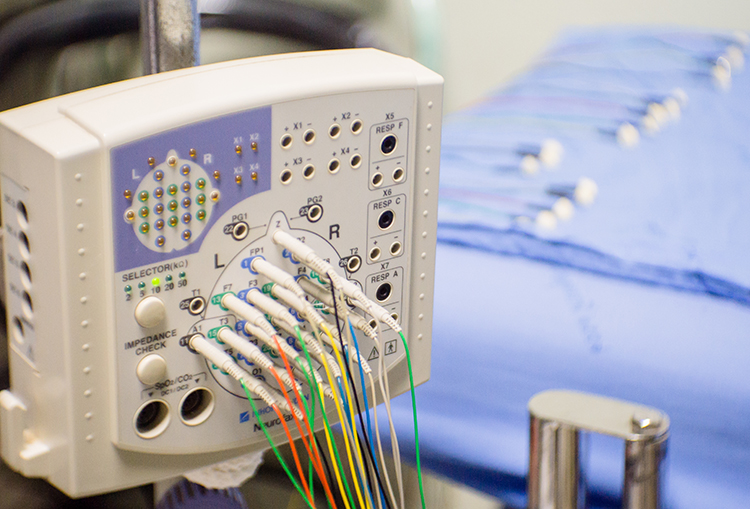
BCIA Blueprint Coverage
Although BCIA addresses the anatomy and physiology of the EEG in its Neurofeedback Blueprint, we include this important topic to provide a comprehensive introduction to the field.

This unit covers
Electrodes, Electroencephalograph, EEG Filters Define the EEG Signal, International 10-20 System, Modified Combinatorial Nomenclature, 10-20 System Electrode Placement, Site Preparation, Elimination of Artifact from EEG Recording, Recognizing Normal EEG Patterns, EEG Displays, and Drug Effects on the EEG.
Please click on the podcast icon below to hear a full-length lecture.

Electrodes
Electrodes detect biological signals. They are also transducers since they convert energy from one form to another. Four types of EEG electrodes are shown below: gold cup, gold flat, silver cup, and silver/silver-chloride ring.
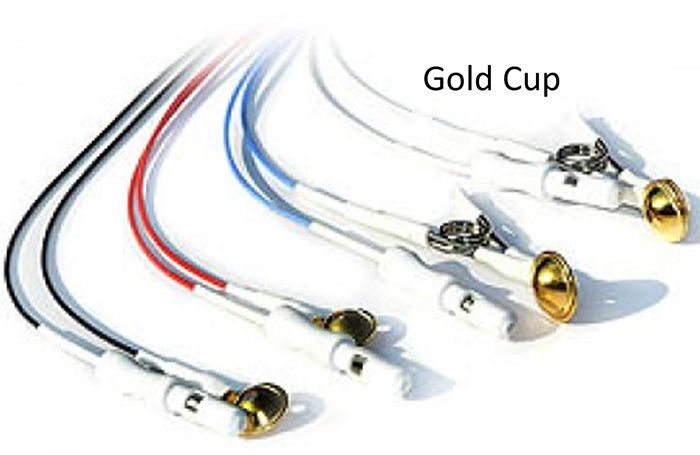
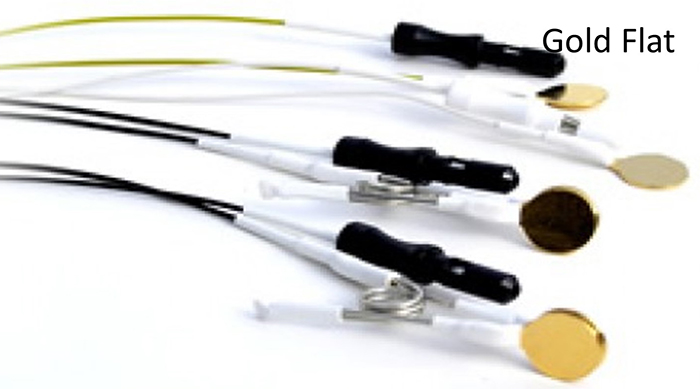
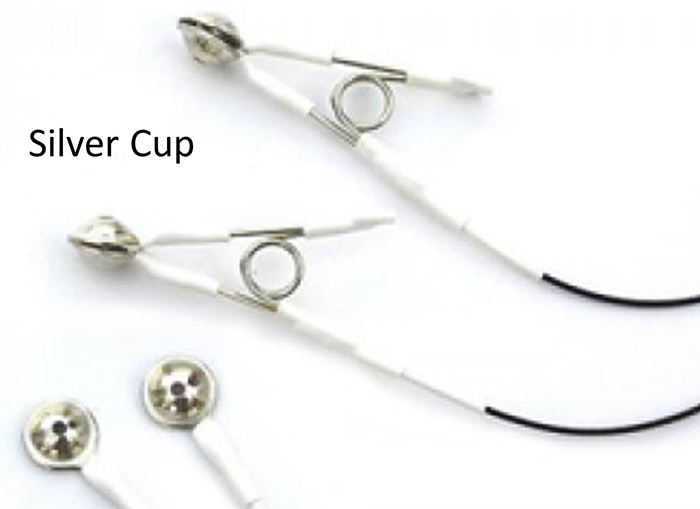
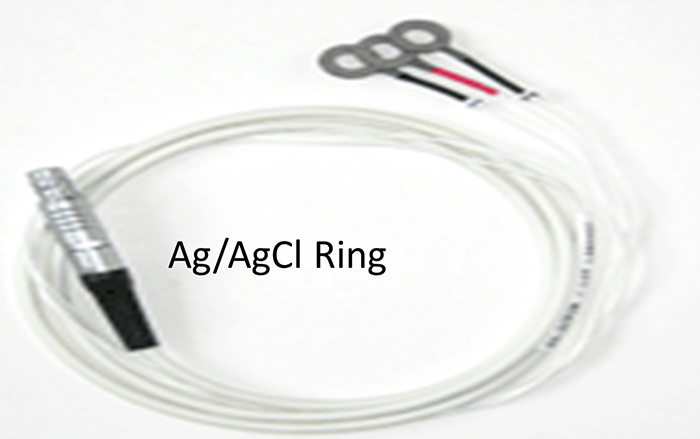
Cap systems like the NeXus EEG cap share a connector containing a pin or other connector for each electrode. These connectors plug all electrodes into the amplifier at the same time.

Consider how EEG electrodes work. In response to chemical and electrical synaptic messages, the dendrites of cortical pyramidal neurons develop excitatory postsynaptic potential (EPSPs) and inhibitory postsynaptic potentials (IPSPs). This ionic current travels about 10-12 centimeters through the cortex, blood vessels, glial cells, interstitial fluid, meninges, and skull to scalp electrodes. This
process is called volume conduction. The photomicrograph below shows the interstitial fluid surrounding tissue through which graded potentials propagate.
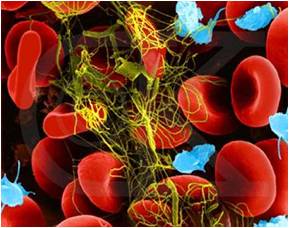
Electrodes transform this current of
ions into a current of electrons that flows through the cable into an
electroencephalograph's input jack.

The EEG signal is attenuated during volume conduction. The volume-conducted signal that
reaches EEG electrodes is measured in
microvolts or millionths of a volt.
How do EEG electrodes work? When an EEG electrode is filled with a conductive gel or paste, the electrode metal donates ions to the electrolyte. In
turn, the electrolyte contributes ions to the metal surface. Electrodes create a DC voltage between the electrode metal and the electroconductive gel or paste. Signal
conduction succeeds as long as electrode and electrolyte ions are freely
exchanged.
Recording Problems
Bias potentials and polarization are two recording problem.
During polarization, conduction breaks down when chemical reactions produce separate positive and negative regions where the electrode and gel contact. Direct current flows across the connection between an electrode and the scalp. The current carries positive ions to the more negative region of this junction and negative ions to the more positive area. This build-up of ions polarizes the electrode so that it favors current flow in one direction and resists flow in the other.
When an electrode is polarized, ion exchange is reduced, and impedance increases, weakening the signal reaching the electroencephalograph. This problem can result from routine clinical use. Electrode manufacturers control this problem using silver/silver-chloride or gold electrodes that resist polarization.
Bias potentials are a second potential recording problem. They result from exchanging metal ions donated by the electrodes and electrolytes without a biological current. We can prevent bias potentials using electrodes with intact surfaces and identical materials (e.g., all gold or silver).
Recording the EEG with Three Leads
We record scalp electrical activity using three recording electrodes: active, reference, and ground. We place the active electrode over a scalp site that is an EEG voltage source. We can locate the reference electrode over the scalp or neutral, but not electrically inactive, sites like an earlobe or the mastoid bone. Finally, we can place the ground electrode on an earlobe, mastoid bone, or scalp (Demos, 2009). The ground electrode is grounded to the amplifier.Active and reference sensors are identical in construction and are each balanced inputs. They are interchangeable! However, some technologies require that you designate a sensor as a reference. For example, linked ears reference.
In the graphic below, the active (+) is red, the reference (-) is black, and the ground electrode (Gnd/Ref) is white.
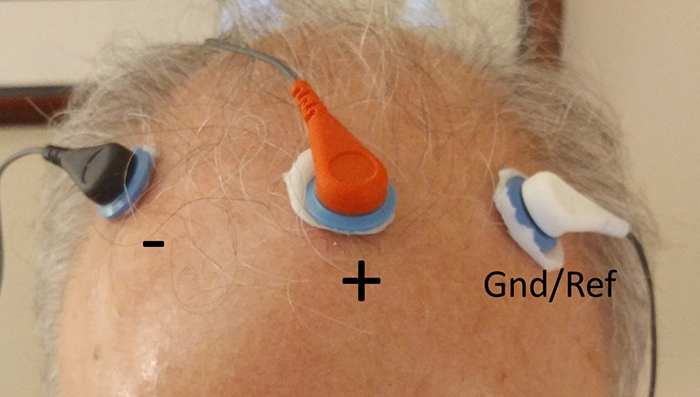
The voltages of the active and reference inputs are based on the ground.
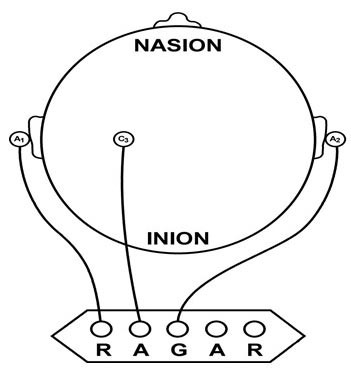
Use of a Limited Number of Electrodes
Peer-reviewed evidence suggests that more EEG channels provide a more accurate assessment and achieve superior clinical or performance outcomes compared with fewer channels (Lau et al., 2012).
Although some practitioners conduct assessment and training with a single channel, assessment and training methods that use more than one channel have become more available. For example, the cost of a full 19-channel EEG assessment has decreased substantially. Such an assessment can provide EEG amplitude data from all sites in the 10-20 system and calculates metrics such as coherence and phase that show how well the 10-20 sites communicate with each other. These data from multi-channel methods are beneficial for complex symptom profiles like those associated with Autism Spectrum Disorders, epilepsy, and traumatic brain injury (Thompson & Thompson, 2016).
A channel is an EEG amplifier output that receives signals from three leads (active, reference, and ground electrodes) placed on the head. These are more appropriately called positive (+), negative (-), and reference. An active or positive electrode is placed over a known EEG generator like Cz. A reference or negative electrode may be located on the scalp, an earlobe, or the mastoid. A ground/reference electrode may also be placed an earlobe or mastoid (Thompson & Thompson, 2016).
Active and reference sensors are identical balanced inputs and interchangeable. However, some neurofeedback data acquisition systems require the designation of a specific sensor as a "reference," as in a linked-ears reference.
A derivation is the assignment of two electrodes to an amplifier's inputs 1 and 2. For example, Fp1 to O2 means Fp1 is placed in input 1 and O2 in input 2.
A montage groups electrodes together (combines derivations) to record EEG activity (Thomas, 2007).
All montages compare EEG activity between one or more pairs of electrode sites.
Modern amplifiers record all input sensors in reference to a common sensor - often Cz - and all montage (sensor comparison) changes are performed in the software. Amplifiers no longer require manual switching of electrodes between inputs.The narrated video below © John S. Anderson displays the same 21-channel recording viewed using different montages with a 60-Hz notch filter on and off.
Electroencephalograph
An electroencephalograph consists of the following stages: differential amplifier, gain amplifier, analog-to-digital converter, digital and FFT filters, and optical isolator.
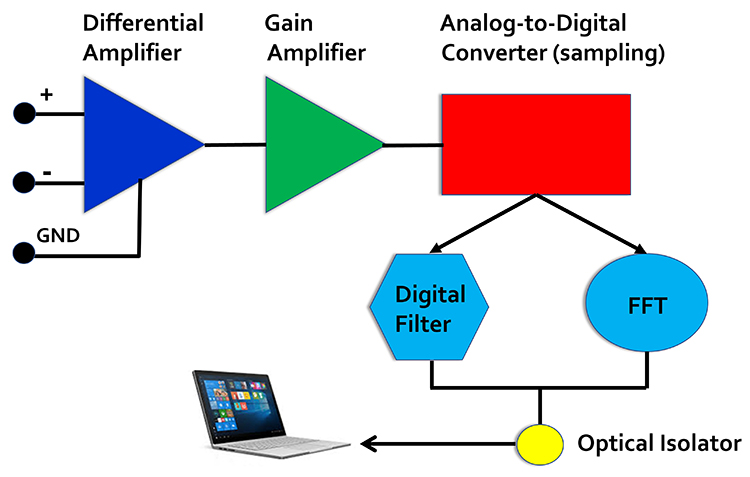
Signal Amplification
The biological signals monitored in biofeedback are very weak. The EEG signal, for example, is measured in microvolts (millionths of a volt). These signals must first be amplified over several stages to isolate the signal we are interested in and then drive displays. Stereo amplifiers perform the same tasks when they boost audio signals above the noise floor to levels that can power loudspeakers.
Amplifiers share the properties of input sensitivity and gain. Input sensitivity is the maximum voltage level an amplifier can accept without clipping and distortion. The graphic below shows the same EEG signal with different sensitivity. The top tracing shows greater sensitivity than the bottom tracing, as evidenced by its substantially greater voltage swings.

Gain is an amplifier's ability to increase the magnitude of an input signal to create a higher output voltage. Gain is the ratio of output/input and is different for AC and DC systems. An amplifier that produces a 1-mV output from a 1-μV input has a gain of 1,000.
Differential Amplifiers
The EEG signal is first boosted by a differential amplifier and next by a gain amplifier. A differential amplifier, also called a balanced amplifier, amplifies the difference between the two inputs: the active (input 1) and reference (input 2). The triangle represents the amplifier and the black circle the output voltage in the diagram below. Graphic © Hand Robot/Shutterstock.com.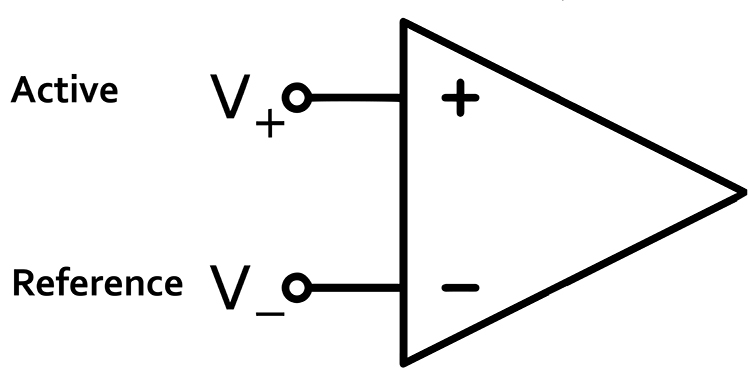
A differential amplifier combines two (or more) identical single-ended amplifiers with balanced inputs. The inputs are referenced to a common ground to compare the resulting signals. The amplifiers are 180o out of phase so that signals that differ in frequency, amplitude, and phase are amplified. Only signal components that differ between two inputs are retained and amplified as output. Signals out of phase or with different amplitudes are "seen" by the common-mode rejection process as different and are passed on for processing.

Frequency is the number of cycles per second (Hz).
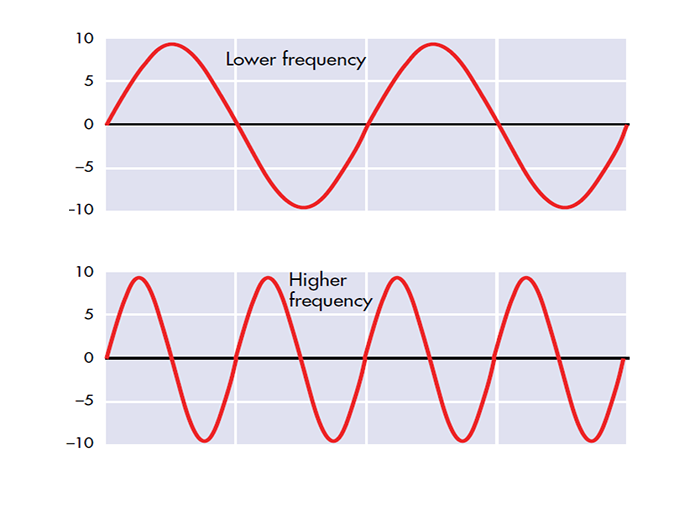
Amplitude is signal voltage or power and is measured in microvolts or picowatts.
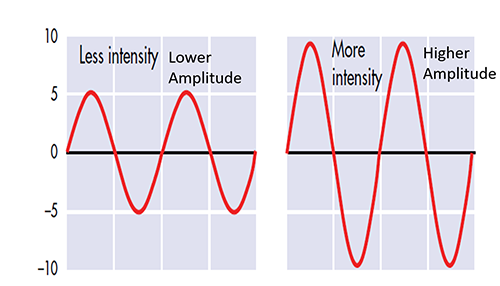
Phase is the similarity in timing of the waves at two locations. Note in the plot on the right, the two signals are 180o out of phase so that the top signal peaks when the bottom signal reaches its trough.
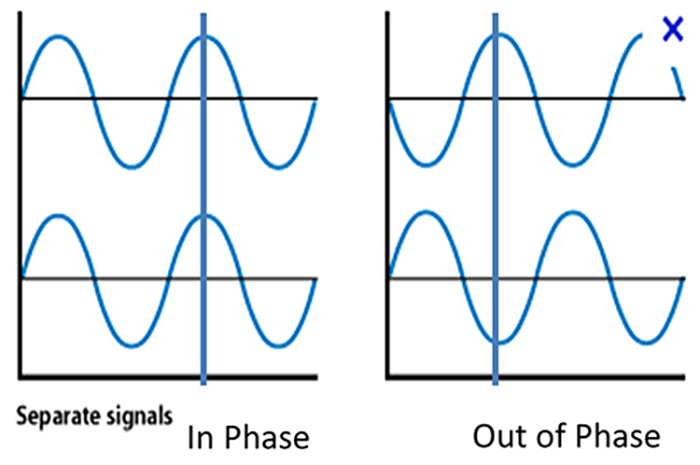
In the recording below, note the red-circled similar signals from the Fp1-LE and Fp1-O2 leads and the O2-LE and Fp1-O2 leads that should be subtracted by common-mode rejection. LE stands for linked ear. LE-LE shows no voltage due to the complete subtraction of identical voltages from the exact anatomical location.
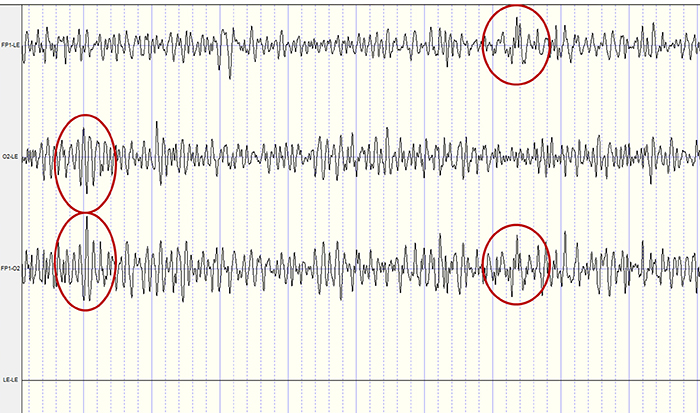
How does this reduce artifact? When there is no EEG activity, identical noise signals reach each amplifier. The differential amplifier subtracts these signals, canceling out the artifact. The output of a perfect differential amplifier would be 0.
The Challenges of Recording Infra-Slow EEG Activity
An AC amplifier has severe limitations when recording infra-slow (0-1 Hz) EEG activity. AC amplifiers exacerbate artifact effects. Client movement, eye movement, sweat, and transient field artifacts produce significant voltage changes. Long time constants over 80 s are recommended to integrate artifact-induced voltages over 2-4-min periods. However, persistent artifacts like eye movement will consistently degrade the signal-to-noise ratio of client feedback.Infra-slow recording requires DC-coupled amplifiers with a large dynamic range produced by 24-bit A/D converters to prevent saturation by slow drifts in baseline voltage. Standard EEG electrodes made of gold, steel, or tin are unacceptable because they suffer capacitance or energy storage, blocking lower frequencies. Silver/silver-chloride electrodes are ideal because they are reversible and do not polarize.
The clinician must distinguish slow artifacts from infra-slow signals. Eccrine sweat glands produce standing millivolt-range potentials. While these can be eliminated by partial skin puncturing, this practice risks infection transmission. Clinicians can identify eye blink and eye movement artifacts by their characteristic location. Body tilt, cough and strain, hyperventilation, and tongue movements produce high amplitude diffuse very slow potentials (Miller et al., 2007).
Common-Mode Rejection
A differential amplifier's separation of signal from artifact is measured by the common-mode rejection ratio (CMRR). Since these amplifiers cancel out noise imperfectly, signal and noise will be boosted. The CMRR specification compares the degree to which a differential amplifier boosts signal (differential gain) and artifact (common-mode gain). CMRR = differential gain/common-mode gain.CMRR should be measured at 50/60Hz where the most energetic artifacts, like power line (50/60Hz) noise, are found. The smallest acceptable ratio is 100 dB (100,000:1), which means that signal is boosted 100,000 times more than competing noise. State-of-the-art equipment exceeds a 180-dB ratio. Lower ratios could result in unacceptable contamination of biological signals.
The graphic below shows common-mode rejection when the common signal is in-phase and out-of-phase.
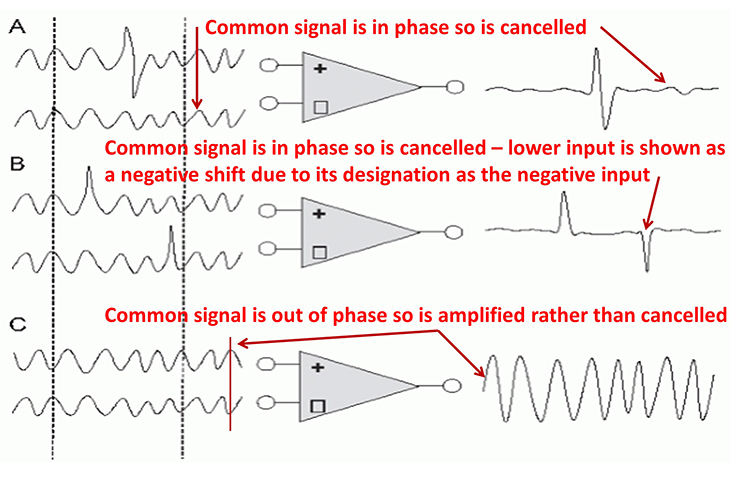
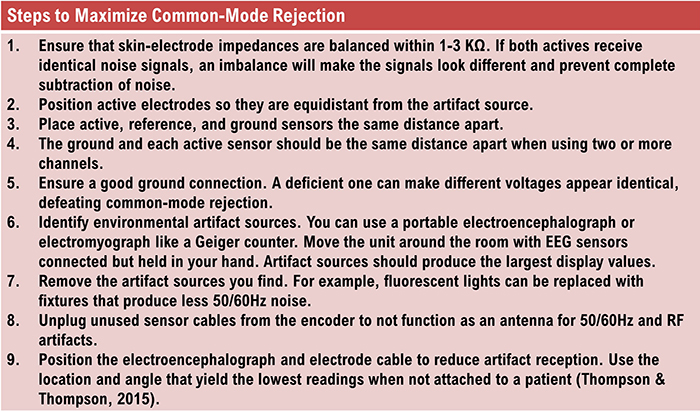
The Effect of Electrode Location on Common Mode Rejection
Brain activity is more similar when electrodes are close together and less similar when farther apart. The effect of electrode spacing means that a differential amplifier may reject actual EEG voltages detected by adjacent electrodes. The sensors were placed at the same anatomical location (Fp1-Fp1) for maximum cancellation, as shown by the flat line in the recording below.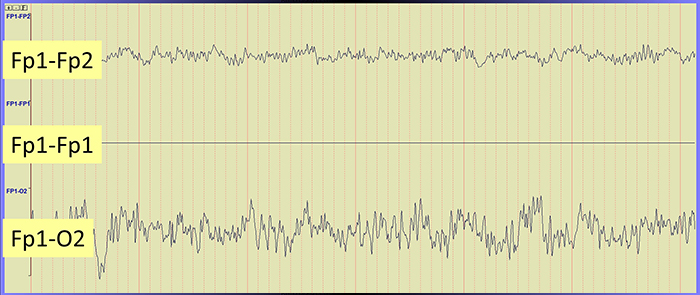
Differential Input Impedance
An amplifier's differential input impedance further reduces the effect of unequal impedances. As EEG signals enter the amplifier, they are dropped across a network of resistors, presenting a differential input impedance in the Gohm (billion ohms) range. State-of-the-art instruments now exceed 10 Gohms. The differential input impedance must be at least 100 times skin-electrode impedance so that 99% or more of the signal can reach the electroencephalograph.Why is this important? Stronger signals help an amplifier differentiate EEG activity from noise, producing more accurate feedback.
Sampling the EEG Signal
An analog-to-digital (A/D) converter samples the EEG signal at a fixed sampling interval. The sampling rate is the number of measurements taken within a given period. The sampling rate must be high enough to represent the signal being measured accurately.
According to the Nyquist-Shannon sampling theorem, an A/D converter's sampling rate should be at least twice the highest frequency component you intend to sample.
The American Clinical Neurophysiology Society (ACNS) guidelines recommend a minimum sampling rate of at least three times the high-frequency filter setting for digitization. This guideline prescribes rates of at least 100 samples per second (sps) for a 35-Hz high-pass filter and at least 200 sps for a 70-Hz high-pass filter (Halford et al., 2016).
A sampling rate of 128 sps is acceptable for visual inspection of the EEG. A rate of 256 sps is typical, and rates from 500-1000 sps are preferred. The graphic below shows the same EEG signal sampled at 32 and 256 sps. The vertical scale (signal amplitude) is identical for both rates.
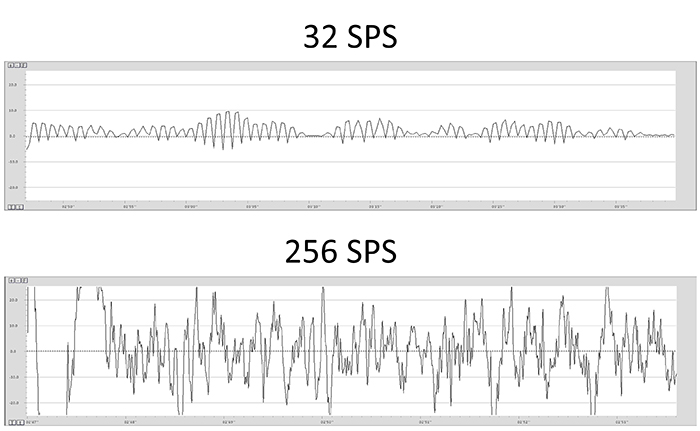
Sampling at rates that are too slow results in aliasing where an analog signal seems to have a lower frequency than it does. In the graphic below © Johns Hopkins University Press, "phantom" slow activity results from too few samples per second. An 11-Hz signal is sampled at 12 and 200 sps. The 12-sps rate produces an aliasing signal shown in black.
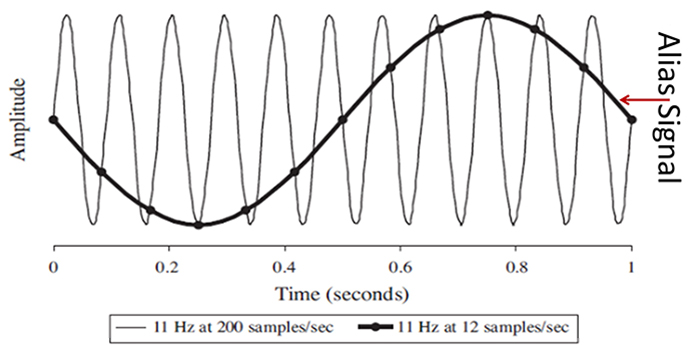
Resolution Depends on Bit Depth
An A/D converter's resolution limits the smallest signal amplitude it can sample. A bit number is the number of voltage levels that an A/D converter can discern. ACNS (Halford et al., 2016) recommends a 16-bit resolution, which can discriminate among 65,536 voltage levels and achieve 0.05-μV resolution. Lower A/D converter resolutions overemphasize small voltage increases.
Signal Properties
We may describe EEG signals by their frequency and amplitude. A/D conversion utilizes digital filters to break the EEG into its component frequencies.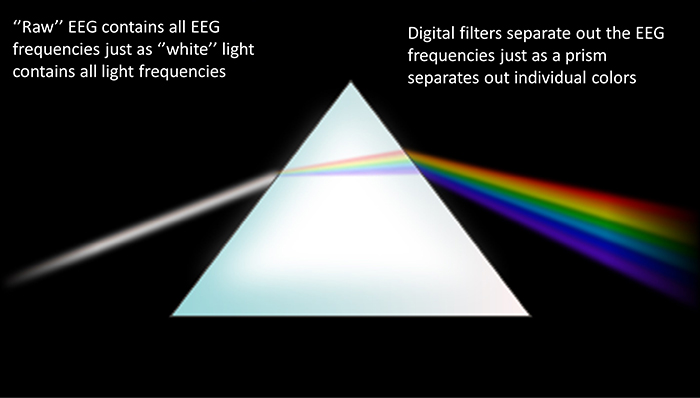
The movie below is a 19-channel BioTrace+ /NeXus-32 display of EEG activity from 1-64 Hz activity broken into component delta, theta, alpha, and beta frequency bands by digital filters © John S. Anderson.
Recall that frequency is the number of cycles completed each second (Hz). The longer the wavelength, the slower the frequency. The delta, theta, alpha, and beta bands can be defined by wave frequency and wavelength as shown in this graphic.
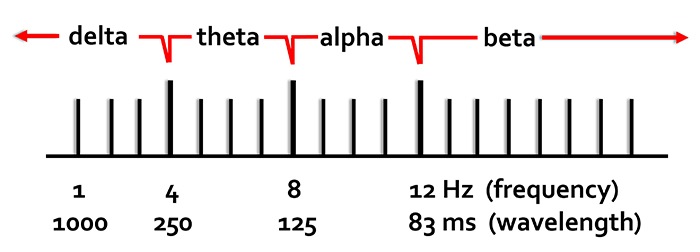
The graphic below shows a 9.5-Hz alpha wave. There are 9.5 peaks during one second.
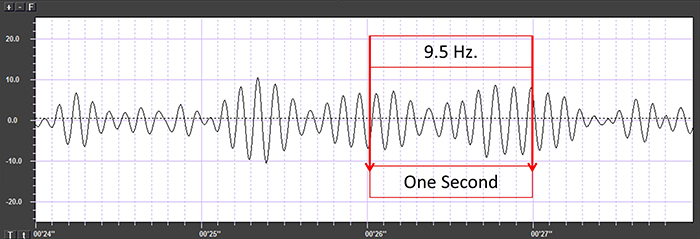
Also, recall that amplitude is signal voltage or power and is measured in microvolts or picowatts. The alpha wave below has a 20-μV amplitude.
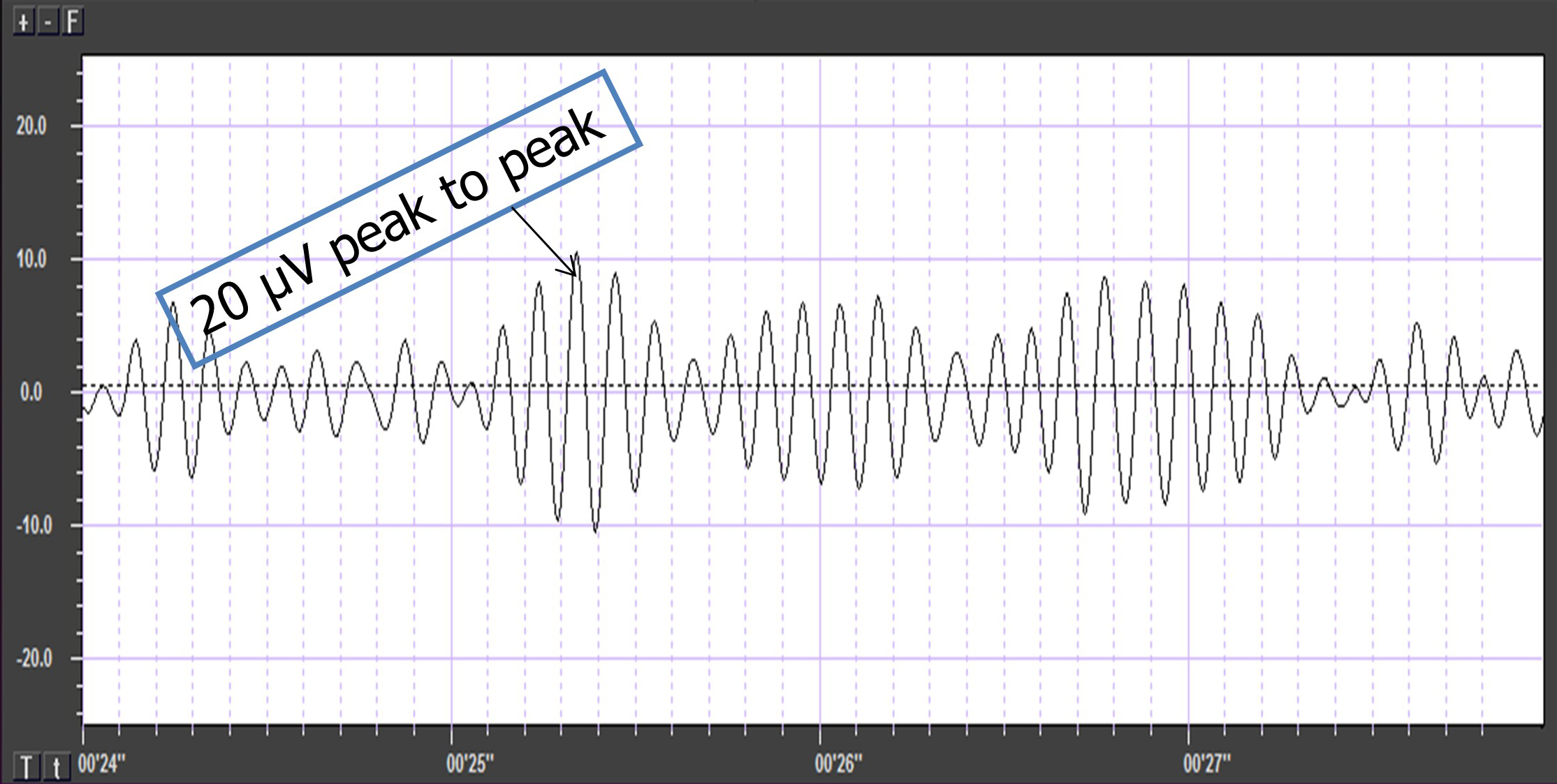
The EEG signal is sent to an integrator to measure signal amplitude in microvolts (μV) or picowatts. Integrators use four methods to calculate the voltage. The peak-to-peak method provides the largest estimate, equivalent to the energy between the positive and negative maximum values of the original AC waveform, which is 2 times peak. The peak voltage is 0.5 of the peak-to-peak value. The root mean square (RMS) voltage is 0.707 of the peak value and 20% higher than the average voltage. The average voltage is 0.637 of the peak value. The graphic below illustrates the peak, peak-to-peak, and root mean square integration methods.

Conversion among these methods is straightforward. If peak-to-peak voltage is 20 μV, the peak voltage is 10 μV, the root mean square voltage is 7.07 μV, and the average voltage is 6.37 μV.

EEG Filters Define the Signal
EEG filters select signals of interest and minimize artifacts. This section will review high-pass, low-pass, bandpass, and notch filters. In the graphic below, the range of frequencies passed through a filter is called the passband, and the range that is sharply attenuated is called the stopband.

A high-pass filter only passes frequencies higher than a set value (e.g., 1 Hz). A low-pass filter only passes frequencies lower than a set value (e.g., 40 Hz). A bandpass filter passes frequencies between the specified values, the "band" of the filter (e.g., 1-40 Hz).


10-Hz Low-Pass Filter
The movie below shows a 10-Hz low-pass filter's output with a vertical scale of 0-50 μV © John S. Anderson.
20-Hz Low-Pass Filter
The movie below shows a 20-Hz low-pass filter's output with a vertical scale of 0-50 μV © John S. Anderson.
30-Hz Low-Pass Filter
The movie below shows the output of a 30-Hz low-pass filter with a vertical scale of 0-50 μV © John S. Anderson.
40-Hz Low-Pass Filter
The movie below shows the output of a 40-Hz low-pass filter with a vertical scale of 0-50 μV © John S. Anderson.
10-Hz High-Pass Filter
The movie below shows a 10-Hz high-pass filter's output with a vertical scale of 0-50 μV © John S. Anderson.
20-Hz High-Pass Filter
The movie below shows a 20-Hz high-pass filter's output with a vertical scale of 0-50 μV © John S. Anderson.
30-Hz High-Pass Filter
The movie below shows a 30-Hz high-pass filter's output with a vertical scale of 0-50 μV © John S. Anderson.
Bandpass Filters
1-40-Hz Bandpass FilterThe movie below shows the output of a 1-40-Hz bandpass filter with a vertical scale of 0-50 μV © John S. Anderson.
8-12-Hz Bandpass Filter
The movie below shows an 8-12-Hz bandpass filter's output with a vertical scale of 0-50 μV © John S. Anderson.
The movie below shows the output of three bandpass filters for delta, theta, and alpha © John S. Anderson.
The movie below shows a "raw" or "wave" display of oscillating electrical information using a positive/negative scale with 0.0 in the middle with the voltage displayed as peak-to-peak μV © John S. Anderson.
The movie © John S. Anderson shows the same alpha waveform plotted along two scales. The top display plots the waveform on a scale that ranges from -20 to +20 μV. The bottom "amplitude" display plots the voltage on a scale that ranges from 0- 50 μV where all values are positive.
The movie © John S. Anderson shows the conversion of the complex EEG signal into its spectral components.
The movie © John S. Anderson shows the spectrum magnitude (average amplitude over a given period) in the top display and power (μV2) in the bottom display.
The movie © John S. Anderson shows the same alpha activity displayed in terms of amplitude (positive voltages), power or amplitude2 (picowatts/resistance), and percent power (signal power as a percentage of total EEG power from 0-100%).
Notch Filter
A notch filter suppresses a narrow band of frequencies produced by line current (e.g., 50/60Hz artifact) shown below by a graphic by Neupsy Key. Use notch filters as a last resort.
The narrated video below © John S. Anderson displays the same 21-channel recording viewed using different montages with a 60-Hz notch filter on and off.
Digital Filters
Digital filters use digital processors, like a digital signal processing (DSP) chip, to exclude unwanted frequencies.
First, an analog-to-digital converter (ADC) samples and digitizes the analog signal, representing signal voltages as binary numbers. Second, a DSP chip performs calculations on binary numbers. Third, a digital-to-analog converter (DAC) may transform the sampled, digitally-filtered signal back to analog form.
Three main methods of digital filtering are Fast Fourier Transformation (FFT), finite impulse response (FIR), and infinite impulse response (IIR).
FFT filters convert the EEG signal into a set of sine waves that vary in frequency, amplitude, and phase.
FIR filters have a finite-duration impulse response and calculate a moving weighted average of digitally-sampled voltages.
IIR filters have an infinite impulse response and employ feedback to calculate a moving weighted average of digitally-sampled voltages.
FFT, FIR, and IIR methods enjoy four advantages over analog filters. First, a clinician can retrospectively adjust the filter settings as they review the EEG record since digital filters are programmable. Second, digital filters can be designed to minimize phase distortion (displacement of the EEG waveform in time). Third, digital filters are stable over time and across a range of temperatures. Fourth, digital filters accurately process low-frequency signals. Graphic © Fouad A. Saad/Shutterstock.com shows the digital reconstruction of an analog waveform.
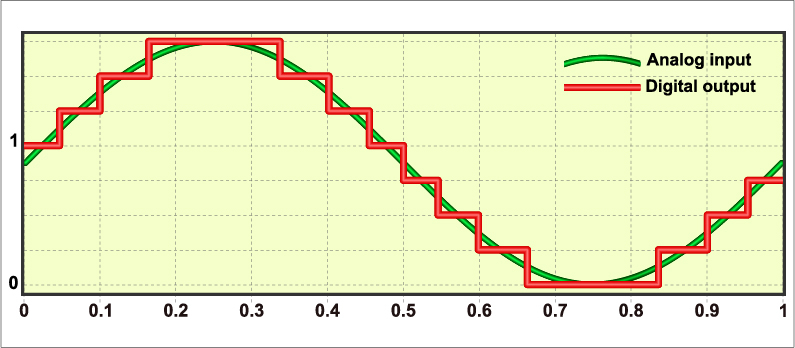
Since these three digital filtering methods can yield different statistical values, they cannot be used interchangeably. Only compare FFT statistics with themselves and not FIR or IIR statistics (Thompson & Thompson, 2016).
Below is a BioGraph ® Infiniti EEG three-dimensional FFT display. Frequency is displayed on the X-axis, amplitude on the Y-axis, and time on the Z-axis.
International 10-20 System
The International 10-20 system is a standardized procedure for electrode placement on 19 scalp and reference and ground sites. Electrodes measure electrical activity from a surrounding area the size of a quarter. Due to neural pathways, the site recorded may be distant from the EEG generator.

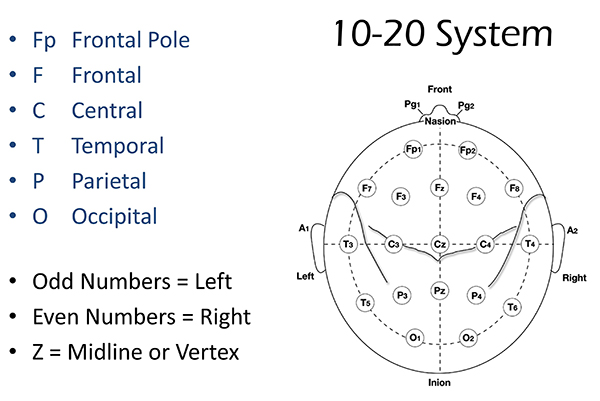
The International 10-20 system calculates two distances: the nasion to the inion and the left to right preauricular notch. The 19 active electrode positions are found taking either 10% or 20% of these distances. Check out the YouTube video The International 10-20 System. The nasion, inion, preauricular points, and vertex are four essential landmarks. Graphic © Alila Medical Media/Shutterstock.com.
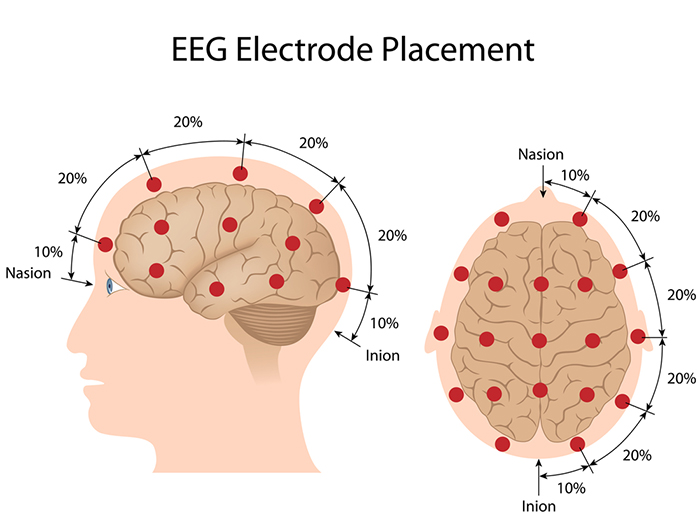
The nasion is the depression at the bridge of the nose.
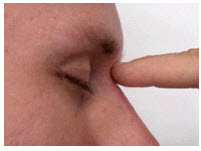
The inion is the bony prominence on the back of the skull in the middle of the inion ridge.
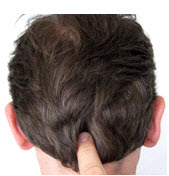
The left and right preauricular points are slight depressions located in front of the ears and above the earlobe. The flap at the opening of the ear is called the tragus.
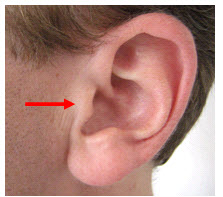
The vertex (Cz) intersects imaginary lines drawn from the nasion to inion and between the two preauricular points. Cz is 50% of the total distance between the nasion and inion and 50% of the distance between the two preauricular points. Minaanandag adapted the diagram below from Fisch (1999).
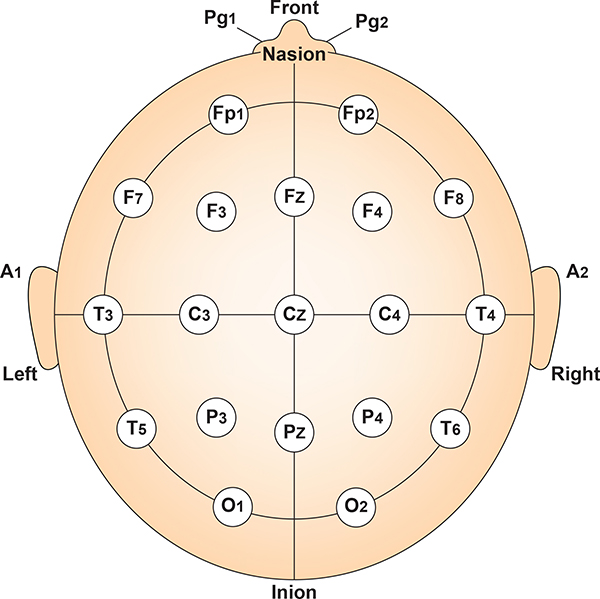
The 10-20 system received its name because electrode sites are separated by 10% or 20% of the distance between two corresponding anatomical landmarks. In the graphic below adapted from Fisch (1999), each midline site is 10% or 20% of the distance from the nasion to the inion.
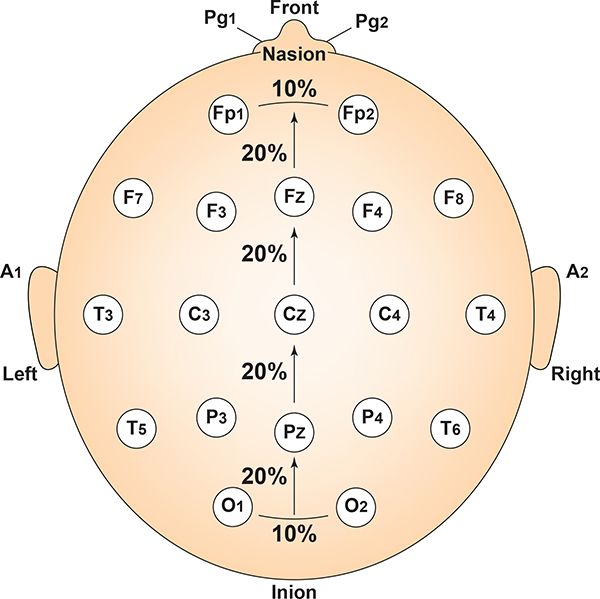
Each horizontal axis site is 10% or 20% of the distance from the two preauricular points. Graphic adapted from Fisch (1999) by minaanandag.
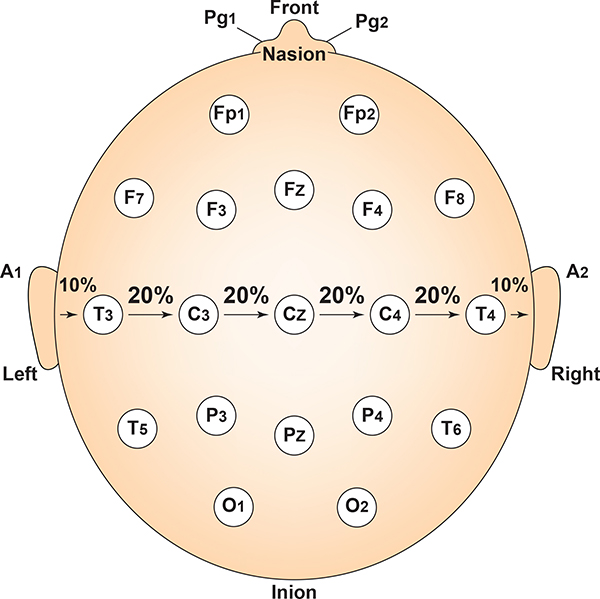
Each circumferential site is 10% of the total circumference, excluding Fpz or Oz. Graphic adapted from Fisch (1999) by minaanandag.
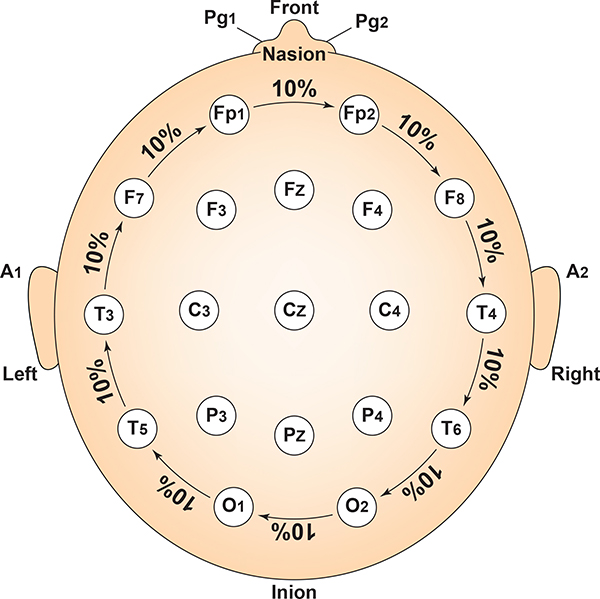
Intermediate sites are halfway between sets of adjacent sites. Graphic adapted from Fisch (1999) by minaanandag.

The graphic by Dailey (2013) shows the correspondence between 10-20 sites and Brodmann areas. There are 47 numbered cytoarchitectural zones of the cerebral cortex based on Nissl staining.
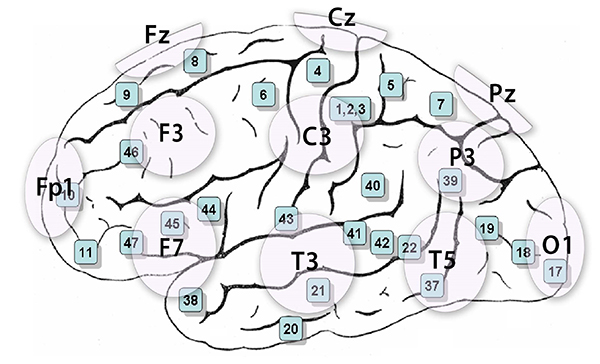
The 10-20 system assigns recording electrodes a letter and subscript. The letters represent the underlying region and include Fp (frontopolar or prefrontal), F (frontal), C (central), P (parietal), O (occipital), and A (auricular). A subscript of z represents a midline (central axis from nasion to inion) placement.
Numerical subscripts range from 1-8 and increase with distance from the midline. The 10-20 system assigns odd-numbered recording electrodes on the left and even-numbered electrodes on the right side of the head. Two reference electrodes are usually placed on the earlobe. John Balven adapted the diagram below from Fisch (1999).
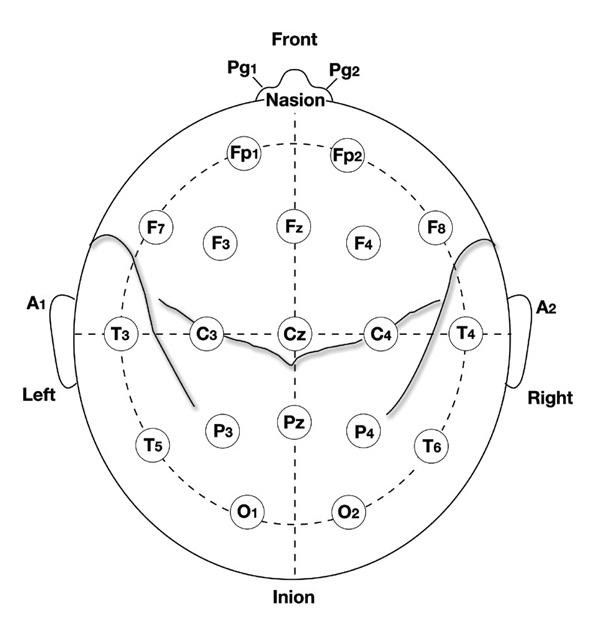
Modified Combinatorial Nomenclature
The American Clinical Neurophysiology Society published guidelines for expanding the 10-20 system to 75 electrode sites. This system, while more complex, also allows us to precisely define the placement sites for our electrodes.
The expansion of the 10-20 system allows clinicians to define the sites midway between two 10-20 sites commonly used in clinical practice, better localize epileptiform activity, increase EEG spatial resolution, and improve detection of localized evoked potentials. The modified combinatorial system replaces inconsistent designations (T3/T4 and T5/T6) with consistent ones (T7/T8 and P7/P8). Black circles depict these replacement sites with white lettering in the diagram below.
The modified combinatorial system, also called the 10-10 system, locates electrodes at every 10% along medial-lateral contours and adds new contours. Each electrode site intersects a medial-to-lateral coronal line (designated by letters) and a longitudinal sagittal line (represented by numerical subscripts).
As with the 10-20 system, letters represent the underlying region and include: N (nasion), Fp (frontopolar or prefrontal), AF (anterior frontal), F (frontal), FT (frontotemporal), FC (frontocentral), A (auricular), T (temporal), C (central), TP (temporal-posterior temporal), CP (centroparietal), P (parietal), PO (posterior temporo-occipital or parieto-occipital), O (occipital), and I (inion). FT and FC lie along the second intermediate coronal line, TP and CP along the third, and PO along the fourth.
A subscript of z represents a midline (central axis from nasion to inion) placement. Numerical subscripts range from 1-10 and increase with distance from the midline. The modified combinatorial system assigns odd-numbered recording electrodes on the left and even-numbered electrodes on the right side of the head David Kelsey adapted the diagram below from Fisch (1999).
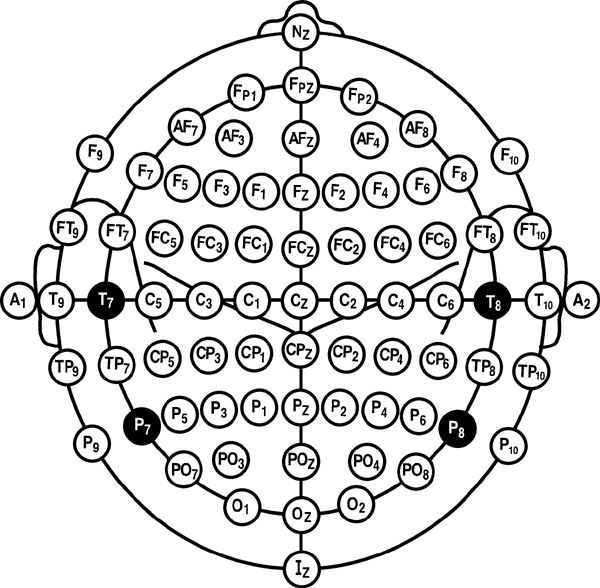
10-20 System Electrode Placement
Short Cuts for Electrode Placement
Most sites do not require all the steps outlined below. Calculate Cz by marking 50% of the nasion-inion distance and 50% of the left-right preauricular distance. You can obtain Fz, Pz, C3, C4, T3, and T4 from these two measurements. The Biofeedback Foundation of Europe generously provided the site location and preparation instructions, and graphics.Step-By-Step Guide for Electrode Placement
Consistently mark perpendicularly on the same side of the measuring tape.
Nasion to Inion – Anterior to Posterior
- Measure from nasion to inion. Note the total and keep the tape measure on this line.
- Mark 50% (or halfway). This is Cz.
- Mark 20% forward from Cz. This is Fz.
- Mark 20% forward from Fz. This is FPz. This should be 10% up from the nasion.
- Mark 20% back from Cz. This is Pz.
- Mark 20% back from Pz. This is Oz. This should be 10% up from the inion.
-
Measure from pre-auricular notch to pre-auricular notch. Find the tragus (the flap at the opening of the ear). Move forward to the indention between the skull and jaw. Place the end of the tape measure at this notch, pass it over Cz, and to the pre-auricular notch on the opposite ear. Record this measurement.
- Mark 50% (or halfway). This should intersect with Cz and form a “+.”
- From Cz, mark 20% on each side toward the tragus. This will be C3 and C4.
- From C3 and C4, mark 20% toward the tragus. This will be T3 and T4. These sites will be 10 percent up from
the pre-auricular notch, directly above the ear.
- Place the tape measure on FPz, T3, Oz, T4, and back to FPz. Record the total circumference.
- From FPz, mark 5% on either side. These are FP1 and FP2.
- From Oz, mark 5% on either side. These are O1 and O2.
- Mark at 10% increments from FP1 and FP2. These are F7 and F8.
- Mark at 10% increments from O1 and O2. These are T5 and T6.
- Measure from Fz to F7: 50% between these points is F3.
- Measure from Fz to F8: 50% between these points is F4.
- Measure from Pz to T5: 50% between these points is P3.
- Measure from Pz to T6: 50% between these points is P4.
Site Preparation
The COVID-19 pandemic has changed site preparation. Now, both clinician and client should wear masks. The clinician should also wear a face shield and gloves.
Once a site is identified and marked, site preparation and sensor placement follow a series of steps when using individual sensors.

- Instruct clients to wash their hair and not use any conditioner or hair-styling products. A recent haircut is helpful (particularly for children), and hair must be brushed or combed.
- Prepare the scalp by cleaning with alcohol. Let the alcohol dry before applying the electrodes.
- The following is a typical recommendation when using older amplifiers. Modern amplifiers with high input impedance do not require this step. Additionally, the following step is controversial because the old standard of achieving skin-electrode impedance below 5 Kohms has been challenged as unnecessary and risks infection transmission (Ferree et al., 2001; Kappenman & Luck, 2010).
We do not recommend this step, especially during the COVID-19 pandemic. Still, we included it because it remains an accepted standard in the field of electroencephalography: Slightly abrade the skin with a blunted needle that you must discard after use to remove dead skin, dirt, and oil that can weaken the EEG signal. - Ask your client to remove jewelry. If your client has pierced ears, do not place the electrode over the hole.
- Scoop up a small quantity of NuPrep™
skin preparation gel or a similar product on a cotton swab or tissue.

- Avoid contaminating the gel tube by avoiding direct contact with the Q-tips ®.

- With the thumb and index finger of one hand, separate the hair around the electrode site that was previously
found and marked.

- Run the gel in the direction of the natural line formed along the scalp by the split hair. Some light force must be used, enough to redden the scalp slightly (again, not recommended but an accepted standard), but not enough to break the skin.
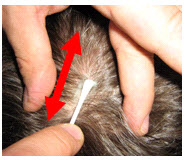
- Wipe away the excess prepping gel with a dry, lint-free cloth. Take care to keep the hair parted and keep
track of the site after wiping clean.
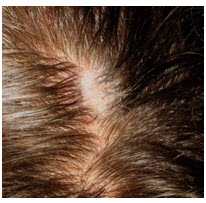
- Use a popsicle or craft stick to cover the electrode with a 1/4-inch layer of Ten20™ conductive paste. Gently press the electrode onto the skin surface until the paste flattens out under the electrode.

- Start by securing the electrode cables to the patient and ensuring strain relief.

- Fill the electrode cup with Ten20™
conductive paste so that no air bubbles exist in the cup.

- Add more Ten20™
conductive paste onto the cup electrode, just enough to form a ball on the cup, not so much that it spills
over the edge. The ideal amount of paste is shown.
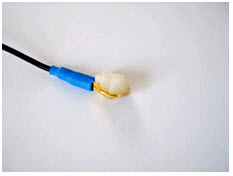
- Place the cup face down on the landing pad previously prepared. Gently push the electrode down to fix it to
the scalp. A little bit of paste should run out along the edge of the cup to form a thin ring around it. Place
the electrode so that the direction of the cable does not place undue stress on the cup (so that it gets
pulled, lifted, or twisted off). The cord should hang naturally and towards the plastic clip (as shown).
Leave enough slack in the cable to allow for comfortable head movement.
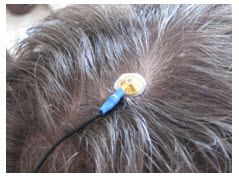
- Repeat the above preparation and placement steps on the earlobes. Do not put too much paste on the ear clip
electrode but ensure that the gold disc is completely covered.

- Leave enough slack in the cable to allow the patient to turn their head easily, but not too much that it can
get caught. Think about the angle of the cable from the ear clip to the neck clip so that no extra tension is
placed on the ear clip. Note the position of the clip, the direction of the cables, and the slack left to
provide mobility. The final configuration should look like the photograph below.
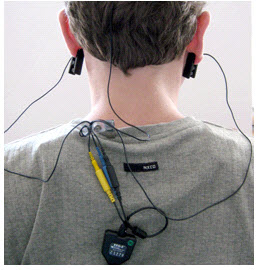
This movie is a 19-channel BioTrace+ /NeXus-32 display of EEG recording © John S. Anderson.
Impedance
In AC circuits, current periodically reverses direction. Current reversal introduces frequency, the number of cycles completed each second. Frequency is measured in hertz (Hz). When an AC travels through a circuit at a given frequency, it encounters a complex form of opposition called impedance (Z) measured in ohms (Ω). Impedance reduces current flow between electrodes and the brain surface.Clinicians perform an impedance test to determine whether they have correctly cleaned and abraded the skin and applied electrodes with sufficient gel or paste (Andreassi, 2007). Excessive impedance means that a weak biological signal must compete at a disadvantage with false electrical signals like powerline artifact. Artifacts could contaminate the EEG signal so severely that an electroencephalograph will display powerline fluctuations instead of cortical activity.

We measure skin-electrode impedance by passing an AC through pairs of electrodes. An impedance test can be manually performed with a separate impedance meter (AC). Graphic from the bio-medical.com website.
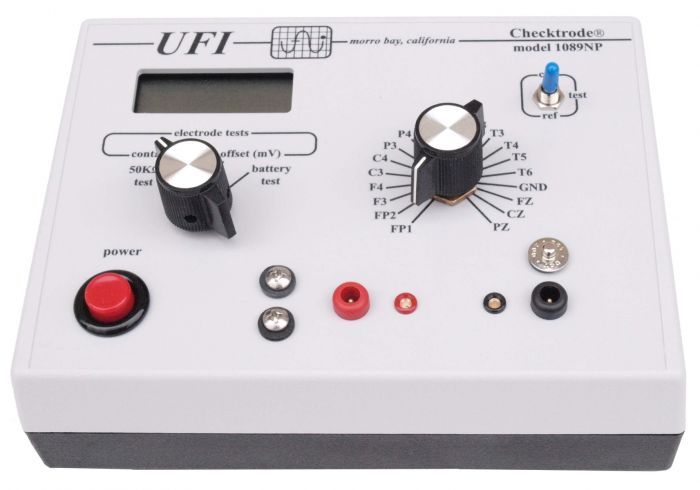
An impedance test may also be performed by software integrated with a data acquisition system and sensors.
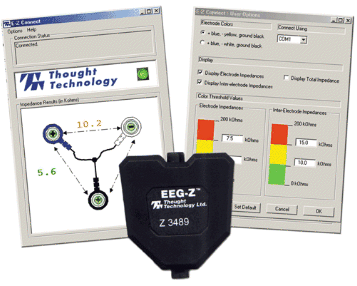
A conservative rule of thumb for EEG research is that impedance should not exceed 5 Kohms and should be balanced within 1 Kohm for each active electrode-reference electrode pair (Hughes, 1994). Modern amplifiers make this standard unnecessary. Moreover, infection concerns make the skin abrasion required to achieve these values unacceptable. Check with your EEG amplifier manufacturer for recommended impedance values.
When the skin-electrode impedance at two sites is unequal, the resulting signals will appear to have different amplitudes when they reach the amplifier, regardless of the actual values. Unbalanced impedance will also increase DC offset values due to the battery effect. The amplifier will boost the resulting inaccurate input, which will be displayed to your client.
When a clinician fails to ensure low and balanced impedances at the start or during a training session, feedback regarding signal amplitude within specific frequency bands will be inaccurate. The wrong thresholds may be selected.
Michael and Lynda Thompson provided an example of an impedance problem that developed during a session because a hyperactive child scratched his ears, resulting in high and imbalanced impedances. Following corrective action that restored acceptable impedance values, high-beta activity (24-32 Hz) declined from 10-15 to 4 μV, gamma activity (45-58 Hz) declined below 2 μV, and SMR and beta activity returned to previous session values (Thompson & Thompson, 2016, p. 66).
DC Offset
DC offset is a voltage that results from combinations of factors include electrode and gel/paste materials, interactions with skin, environment (humidity and temperature), and sweat gland activity due to stress level. The DC offset value should be consistent across all sensors and less than 25,000 μV, ideally below 10,000 μV. DC offset graphic © John S. Anderson.
Tracking Tests
An EEG tracking test confirms whether an EEG responds to changes in brain function caused by verbal instructions. For example, when recording from the occipital lobe, ask the client to close their eyes (alpha amplitude should increase) and then focus on a nearby object (alpha amplitude should decrease).Elimination of Artifact from EEG Recording
BCIA's Neurofeedback Essential Skills List requires that applicants identify and remove artifact sources appearing in EEG recordings. Once you understand the mechanics and appearance of routine artifacts, Peper et al. (2008) recommend that you intentionally reproduce them to better recognize and prevent them.

Brain map validity depends on the integrity of the raw EEG. You will need 45 s of reasonably clean data to construct a valid brain map from raw EEG recordings 3-10 min in length. However, the ideal amount of clean data is approximately 2 min for adequate database comparison. Realize that longer recordings risk increased drowsiness artifacts and sleep. Therefore, it is helpful to speak to the client to help them maintain alertness occasionally. Simply saying how much time is left every 1-2 min is usually enough to accomplish this.
Stage 1 sleep is a subtle drowsy state that clients often do not recognize. This state change is seen as a decrease in alpha and an increase in theta amplitudes. There will be slow ey- rolling movements and decreased EMG and beta. Stage 1 sleep graphic © John S. Anderson. Note the increased theta amplitudes in the spectral displays for channels 1 and 2.
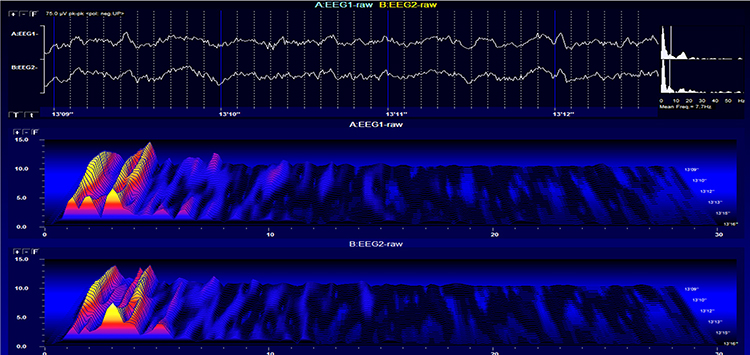
The less frequent the artifact, the shorter the required recording period. Disable low-pass and high-pass filters before editing to better visualize electro-ocular and SEMG artifacts.
Worst case, as with a hyperactive child, none of the EEG channels may contain usable data, and you will need to repeat the assessment. Where artifact only contaminates a few channels, you may base assessment on the clean channels (Demos, 2019).
Strategies to Reduce Artifact
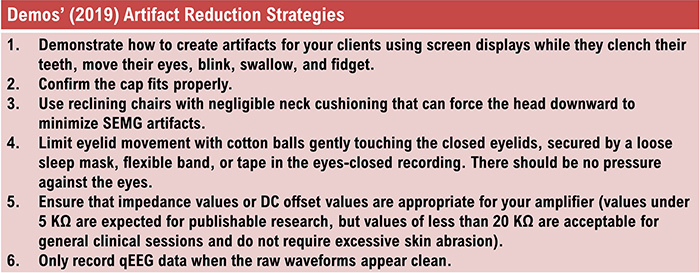
The movie is a 19-channel BioTrace+ /NeXus-32 display of EEG processing in NeuroGuide™ © John S. Anderson.
Recognizing and Correcting Signals of Noncerebral Origin
EEG artifacts, consisting of noncerebral electrical activity, can be divided into physiological and exogenous artifacts. Physiological artifacts include electromyographic, electro-ocular (eye blink and eye movement), cardiac (pulse), sweat (skin impedance), drowsiness, and evoked potential. Exogenous artifacts include movement, 60 Hz and field-effect, and electrode (impedance, bridging, and electrode pop) artifacts.
Electromyographic (EMG) Artifact
EMG artifact is interference in EEG recording by volume-conducted signals from skeletal muscles. This artifact contains high-frequency activity that resembles a "buzz" of fast activity during a contraction. EMG is seen as fast beta activity in the qEEG. While some frequencies are between 10-70 Hz, most are 70 Hz or higher.The graphic shows how high-frequency filter (HFF) selection can affect contamination by this artifact. A high-frequency filter (low-pass filter) attenuates frequencies above a cutoff frequency. In the examples below, the cutoffs are 35 Hz and 15 Hz.
All the channels on the left side of the tracing show SEMG artifact admitted by a 35-Hz high-frequency filter. The right tracing is free from SEMG artifacts since its 15-Hz high-frequency filter attenuates the higher frequencies that contain this artifact.
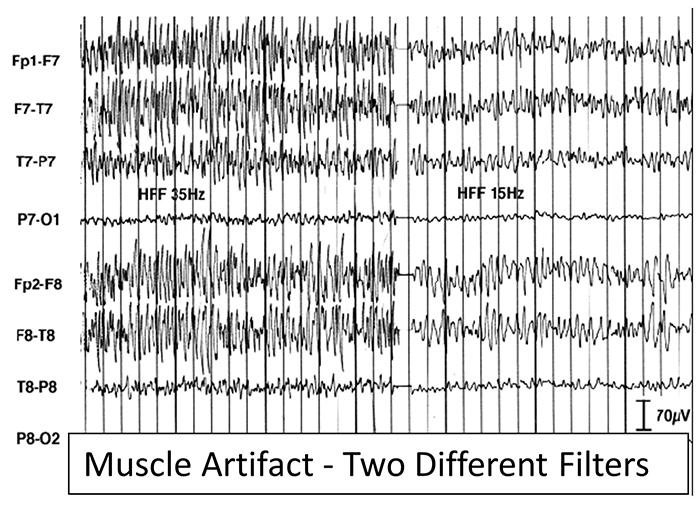
The following graphic shows how gum chewing can generate SEMG artifacts by contracting the muscles of mastication. Graphics © eegatlas-online.com.
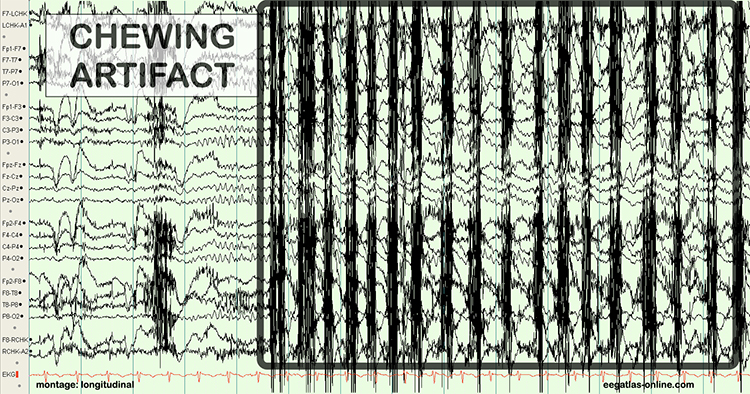
The frequency spectrum for SEMG artifacts ranges from 2-1,000 Hz. While strong contraction can contaminate all frequency bands, including 10 Hz, the beta rhythm (at 70 Hz or higher) is most affected by this artifact. EMG artifacts may create the appearance of greater beta activity than is present. Graphic © eegatlas-online.com.
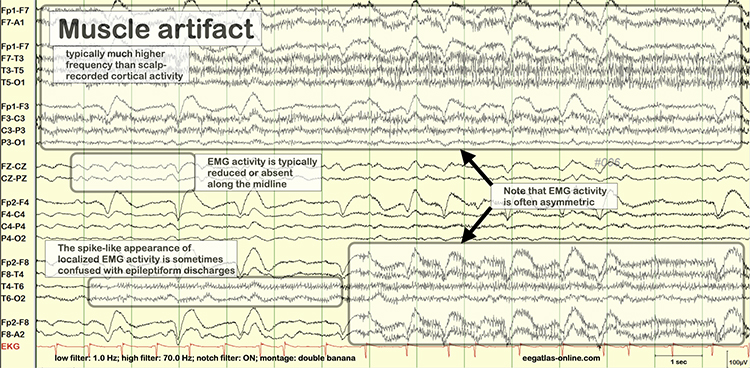
Below is a BioGraph ® Infiniti EMG artifact display. Note how the amplitude of the EEG spectrum increases with each contraction.
Thompson and Thompson (2016) observed that EMG artifacts are readily detected because they affect one or two channels, particularly at T3 and T4 at the periphery, and less often at O1, O2, Fp1, and Fp2.
You can identify EMG artifacts by visually inspecting the raw signal. The following graphic shows SEMG artifacts using a 70-Hz high-frequency filter.
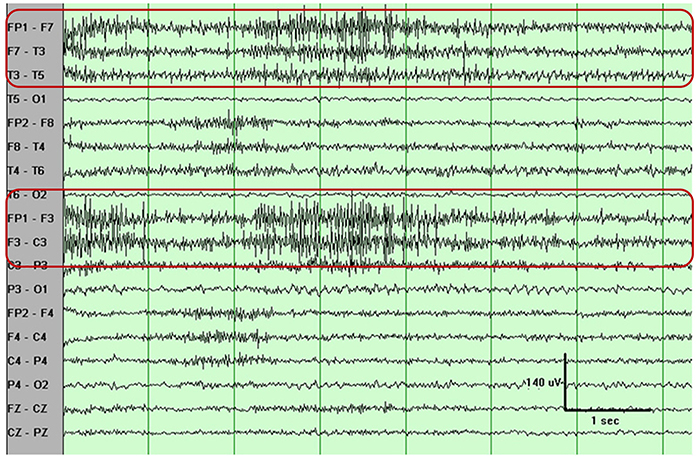
Electro-Ocular Artifact
Electro-ocular artifact contaminates EEG recordings with potentials generated by eye blinks, eye flutter, and other eye movements. For example, anxious patient eyelid flutter may cause deflections at Fp1 and Fp2 (Klass, 2008).This artifact is due to the eye's electrical field's movement when the eye rotates and contraction of the extraocular muscles. The eye creates a dipole that is electropositive at the front and electronegative at the back. Bell's Phenomenon refers to the upward rotation of the eye when it closes, causing the artifact to appear as an increase in EEG.
The following two graphics show eye movement artifacts due to rapid blinking. Graphics © eegatlas-online.com.
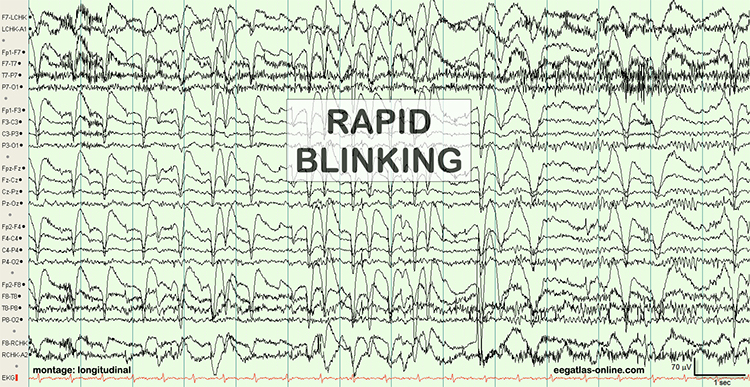
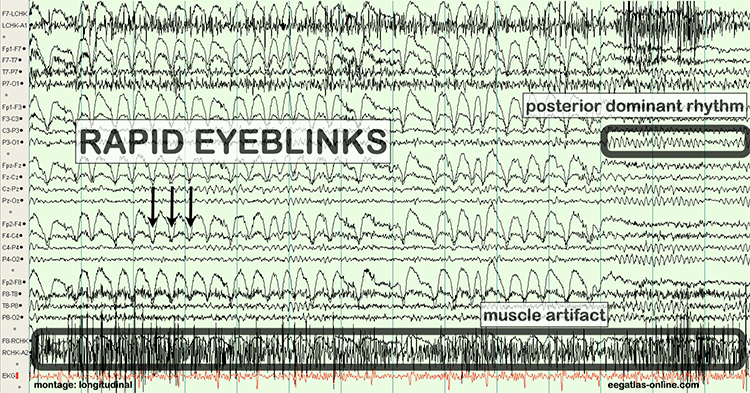
The following graphic shows eye blinks, sharp lateral eye movement, and slow lateral eye movement.
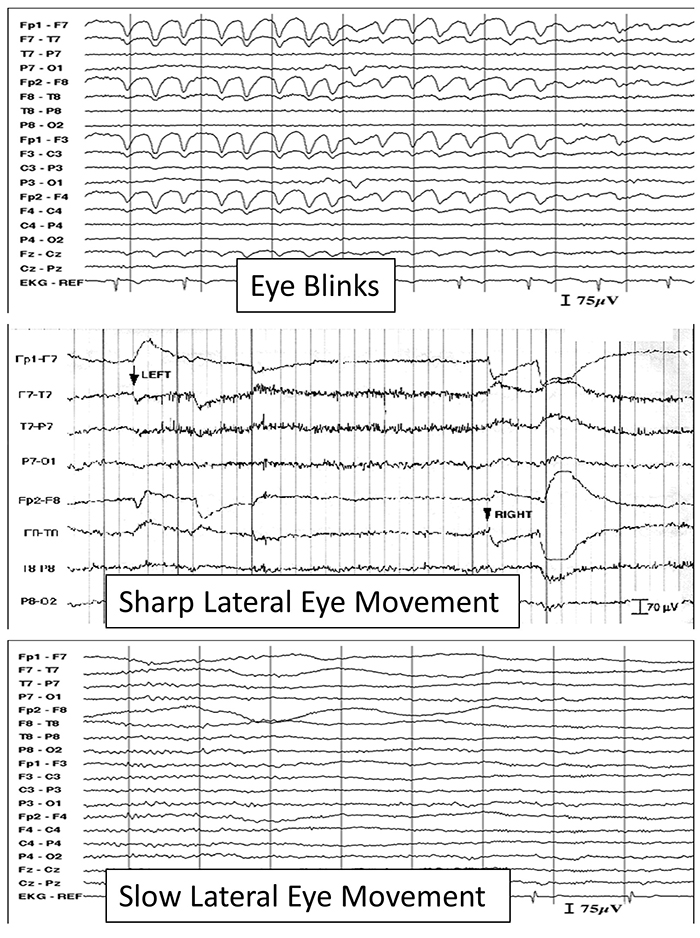
Below is a BioGraph ™ Infiniti EEG display of eye movement artifact.
Below is a NeXus display of eye blink and EMG © John S. Anderson.
An upward eye movement will create a positive deflection at Fp1, while a downward eye movement may create a negative deflection. In a longitudinal sequential montage, an artifact is typically seen at frontal sites (Fp1- F3 and Fp2-F4). A left movement may produce a positive deflection at F7 and a negative deflection at F8 (Thompson & Thompson, 2015).
Rapid eye flutter may resemble seizure activity. Graphic © John S. Anderson.
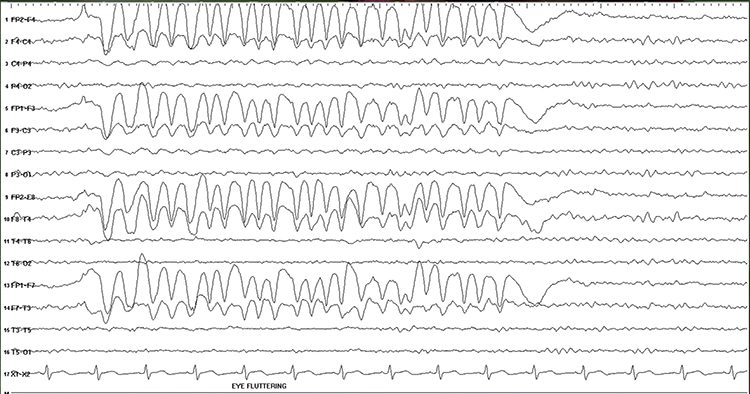

Cardiac and Pulse Artifacts
Cardiac artifact occurs when the ECG signal appears in the EEG. This artifact may be produced when electrode impedance is imbalanced or too high or when an ear electrode contacts the neck. The frequency range for ECG artifact is 0.05-80 Hz, and it contaminates the delta through beta bands. Since multiple electrodes detect this artifact, it can create the appearance of greater coherence than is present. Graphic © eegatlas-online.com.
You can detect cardiac artifacts by inspecting chart recorder, data acquisition, or oscilloscope displays of the raw EEG waveform. Cardiac artifact appears as a wave that repeats about once per second (Thompson & Thompson, 2016). Below is a BioGraph ® Infiniti ECG artifact display.
Pulse artifacts are due to the mechanical movement of an electrode with respect to the skin surface due to the pressure wave of each heartbeat. Graphic © eegatlas-online.com.
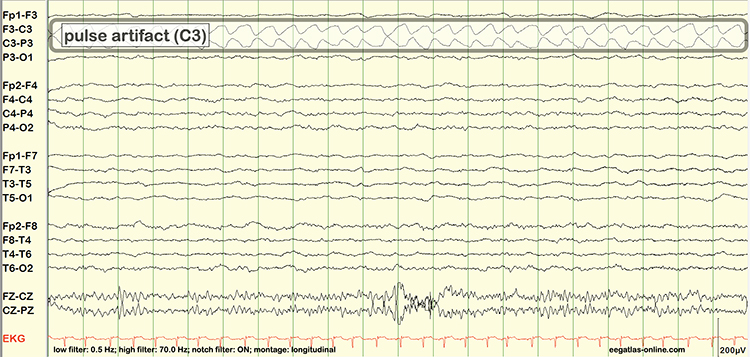
Sweat (Impedance) Artifact
Sweat artifact results from sweat on the skin changing the conductive properties under and near the electrode sites (i.e., bridging artifact). Sweating reduces electrode contact with the scalp and generates large-scale up and down EEG line movements in several frontal channels. This artifact is often elicited by abrupt, unexpected stimuli and usually appears as isolated 1-2 Hz slow waves of 1-2-s duration at frontal and temporal sites (Thompson & Thompson, 2015). Graphic © eegatlas-online.com.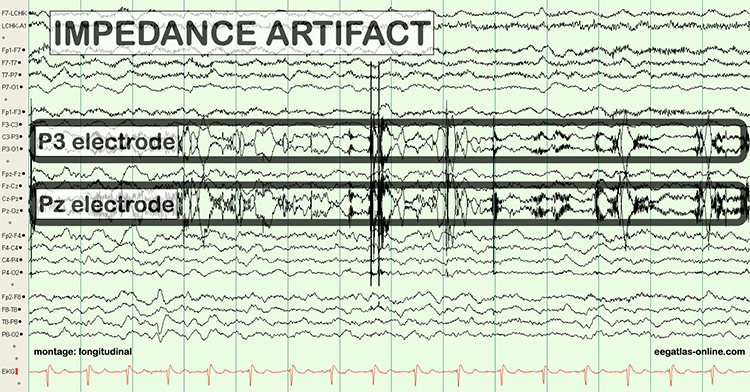

Bridging Artifact
A short circuit produces a bridging artifact between adjacent electrodes due to excessive application of electrode paste or a client who is sweating excessively or who arrives with a wet scalp. Bridging artifacts can cause adjacent electrodes to create a short circuit between adjacent electrodes that produces identical referential EEG recordings or a flat line with a bipolar montage. The Fp1-F3 channel's reduced amplitude and frequency illustrate bridging artifact.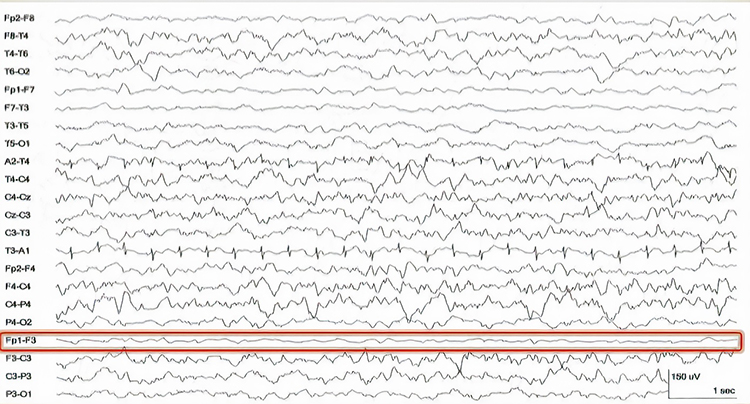
Drowsiness Artifact
Drowsiness artifact is the appearance of stage 1 or stage 2 sleep in the EEG. Stage 1 and stage 2 of sleep are most likely during eyes-closed recording. Sleep may occur during eye-closed awake recording. Graphic © eegatlas-online.com.
Stage 1 sleep is a subtle drowsy state of which clients are often not aware. The EEG will show a decrease in alpha (especially occipital) and an increase in theta amplitudes (especially frontal). Slow eye-rolling movements will be accompanied by reductions in EMG and beta amplitude. Sleepiness may be accompanied by spike-like transients (vertex or V-waves). The graphic below © John S. Anderson shows increased theta during stage 1 sleep.
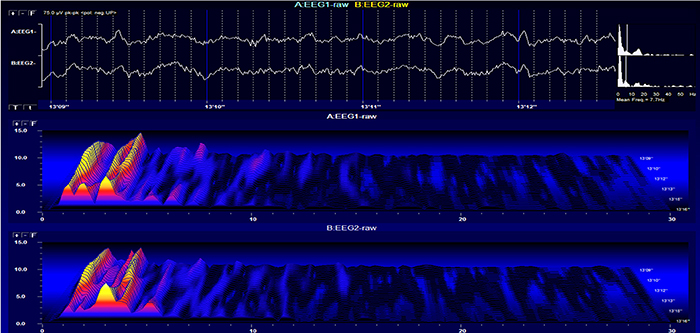
When you detect drowsiness artifact during a training session, suspend recording and instruct your clients to move their hands and legs to increase wakefulness.
Evoked Potential
Evoked potential artifact (also called event-related potential artifact) consists of somatosensory, auditory, and visual signal processing-related transients that may contaminate multiple channels of an EEG record. While evoked potentials increase recording variability and reduce its reliability, they minimally affect averaged data (Thompson & Thompson, 2015).The graphic below is courtesy of BPM biosignals' YouTube video EEG: Visually evoked potentials (VEP).
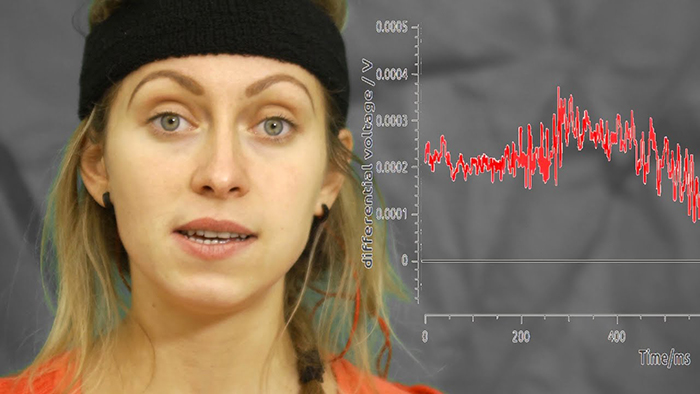
Movement Artifact
Movement artifact is caused by client movement or the movement of electrode wires by other individuals. Most of these artifacts are produced by brief changes in electrode-skin surface connection. Cable movement is called cable sway. The graphic below that illustrates cable sway is courtesy of iMotions.com.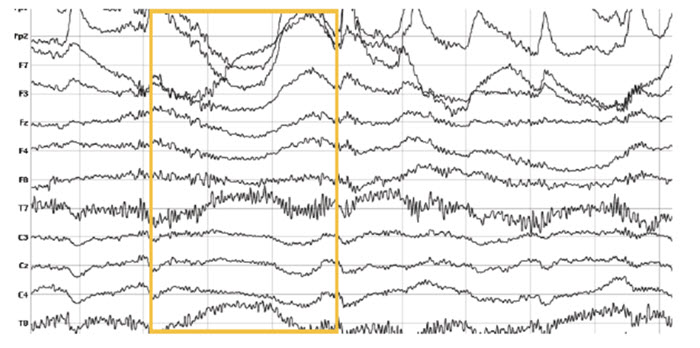
Movement artifacts can produce high-frequency and high-amplitude voltages identical to EEG and EMG signals. While the delta rhythm is most affected by this artifact, it may also contaminate the theta band (Thompson & Thompson, 2016). Graphic © eegatlas-online.com.
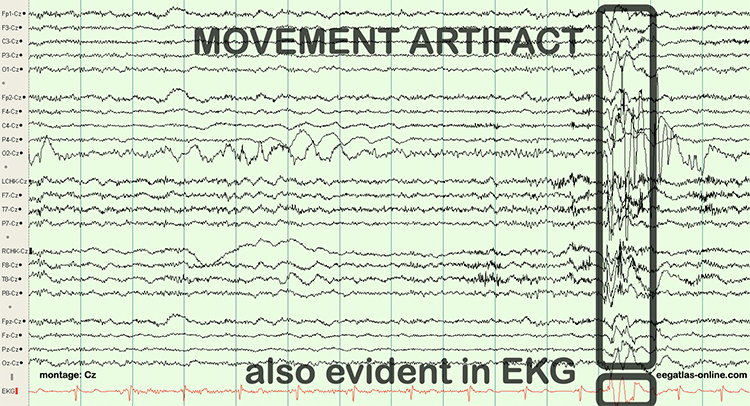
The graphic below shows movement artifacts due to head movement (left), respiration (center), and tongue movement (right).
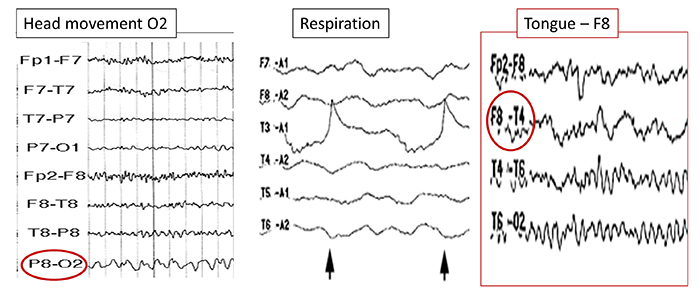
Below is a BioGraph ® Infiniti cable movement artifact display. Note the two voltage spikes at the beginning of the recording.
50/60 Hz and Field Artifacts
Both 50/60 Hz and field artifacts are external artifacts transmitted by nearby electrical sources. While 60-Hz artifact is a risk in North America where AC voltage is transmitted at 60 Hz, 50-Hz artifact is a problem in other locations that generate power at 50 Hz. Their fundamental frequency is 50 or 60 Hz with harmonics at 100/120 Hz, 150/180 Hz, and 200/240 Hz. Imbalanced electrode impedances increase an EEG amplifier's vulnerability to these artifacts. The 60-Hz artifact graphic below © John S. Anderson.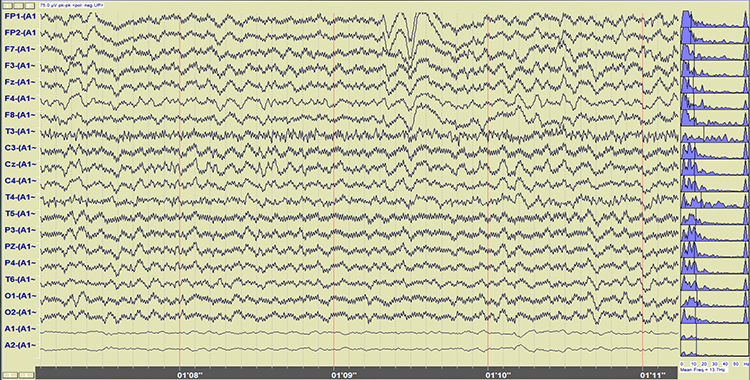
A BioGraph ® Infiniti display of 60-Hz artifact is shown below in red. Note the cyclical fluctuation in voltage and 60-Hz peak in the power spectral display.
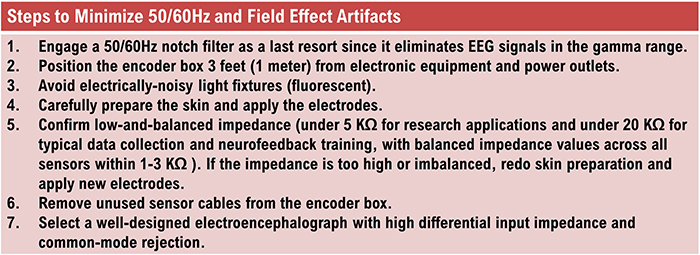
Radiofrequency Artifact
Radiofrequency (RF) artifact radiates outward like a cone from the front of televisions and computer monitors. Graphic © eegatlas-online.com.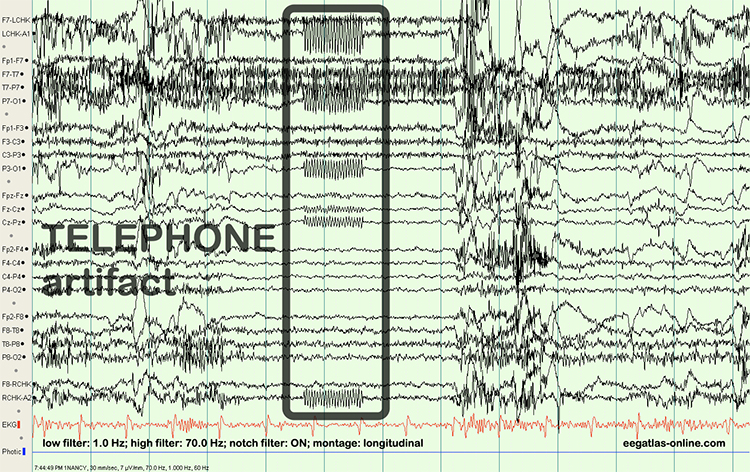
 Artifacts.jpg)
Electrode Artifacts
There are several sources of electrode artifacts. Even with proper care, electrode surfaces can corrode, and the leads and connectors can break. Using sensors with mismatched electrode metals can cause polarization of amplifier input stages.Impedance Artifact
Unless skin-electrode impedance is low (under 5 KΩ for research and 20 KΩ for training) and balanced (under 1-3 KΩ ), diverse artifacts like 50/60 Hz and movement can contaminate the EEG signal, as seen in the P3 and Pz electrodes. Graphic © eegatlas-online.com.
Electrode Pop Artifact
Even when the impedance is low and balanced, mechanical disturbance can produce a unique artifact. Electrode pop artifact creates a sudden large deflection in at least one channel when an electrode abruptly detaches from the scalp. This artifact may also happen when there is a bubble or other defect in the gel or paste, and a charge builds up and subsequently "jumps" across the gap, resulting in a large electrical discharge. Graphic © John S. Anderson.
Recognizing Normal EEG Patterns
This section covers normal EEG patterns, including the posterior dominant rhythm and differences between eyes-open and eyes-closed resting conditions.
Normal EEG Patterns
The healthy adult EEG is a cerebral symphony comprised of theta, alpha, sensorimotor rhythm, beta, and gamma activity. We will survey the generators, distributions, and behavioral correlates of these rhythms. EEG rhythms correlate with patterns of behavior (level of attentiveness, sleeping, waking, seizures, and coma). They occur in distinct frequency ranges and are characterized by synchrony and desynchrony.Synchrony means that pools of neurons coordinate their firing due to pacemakers (top) and mutual coordination (bottom).
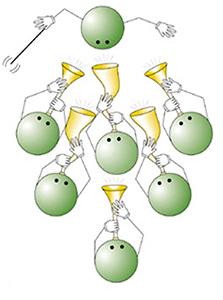
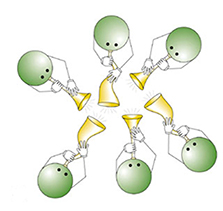
The synchronized EEG graphic below © John S. Anderson.
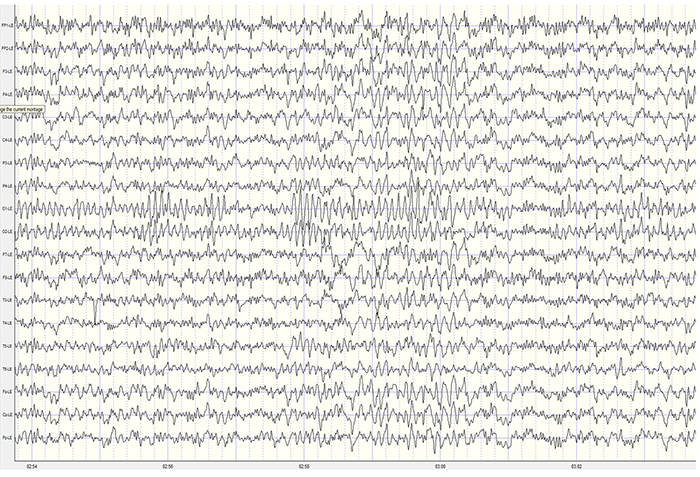
Desynchrony means pools of neurons fire independently due to stimulation of specific sensory pathways up to the midbrain and high-frequency stimulation of the reticular formation and nonspecific thalamic projection nuclei.
The desynchronized EEG graphic below © John S. Anderson.
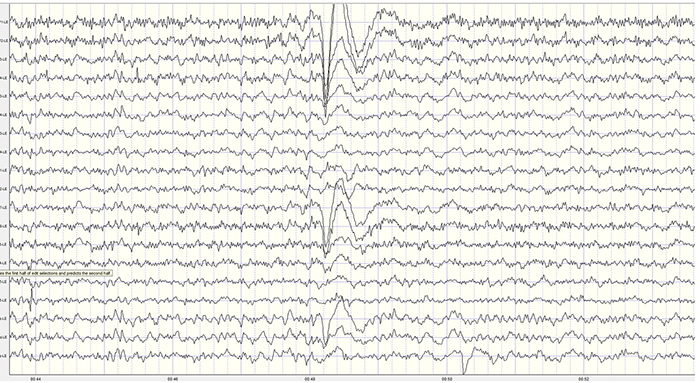

Graphic © John S. Anderson.
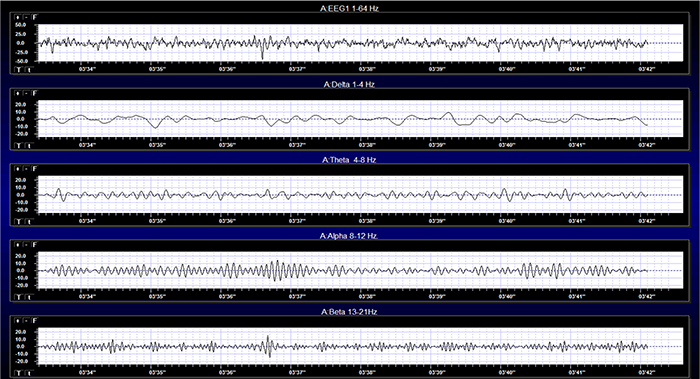
Effect of Eyes Open and Closed Conditions on the EEG
The alpha rhythm is strongly modulated by visual input. Opening the eyes blocks or reduces the occipital alpha rhythm. Hans Berger (1929) originally described this phenomenon. In contrast, eyes-closed alpha is associated with alert wakefulness and reduced visual input (Thompson & Thompson, 2016).The movie below is a 19-channel BioTrace+ /NeXus-32 display of eyes open and closed EEG © John S. Anderson. Note the appearance of alpha activity with eyes closed at about 14 seconds and alpha-blocking with eyes open at about 45 seconds.

The graphic below illustrates alpha-blocking and is courtesy of iMotions.
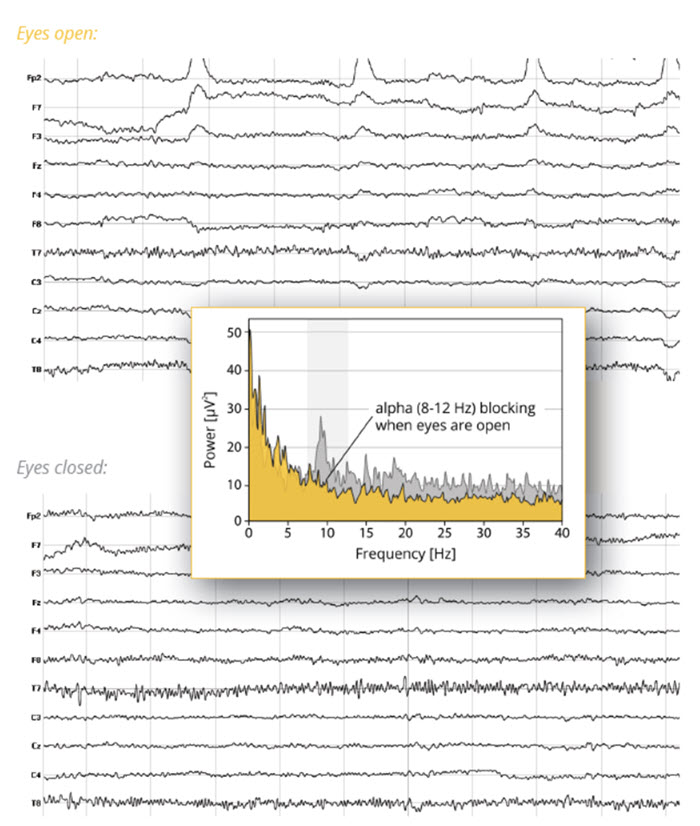
Posterior Dominant Rhythm
The posterior dominant rhythm (PDR) is the highest-amplitude frequency detected at the posterior scalp when eyes are closed. A healthy adult PDR is 10 Hz. Values below 9 Hz and above 11 Hz are abnormal, may result from psychoactive drugs, and may be associated with clinical symptoms like anxiety (Demos, 2019). Graphic © eegatlas-online.com. See the PDR at P3-O1.
EEG Displays
Epoch
An epoch is an EEG signal sampling period, and an epoch number (like epoch 52) is used to index a location in a session's record. One second is the most common sample when quantifying the EEG. A clinician should obtain at least 60 epochs of artifact-free data for valid assessment (La Vaque, 2003).EEG Time Constant
An EEG time constant is the period that an EEG signal is averaged before a value is displayed. Lubar (1989) recommends a 0.5-second delay between detecting and displaying EEG signals to preserve the contingency between EEG events and feedback.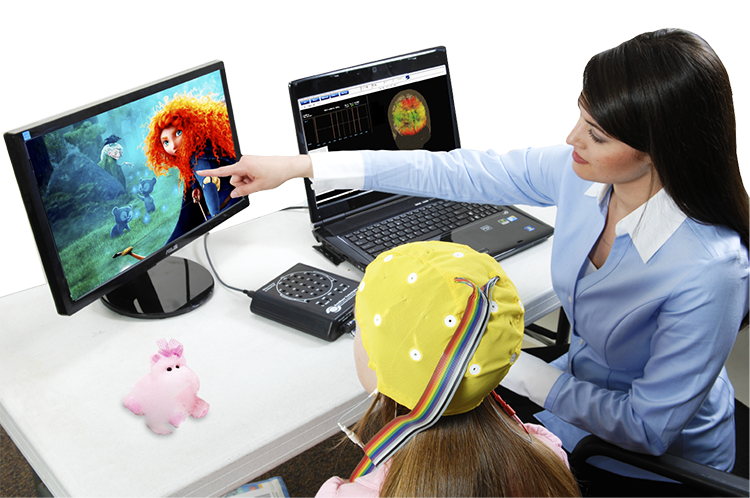
Drug Effects on the EEG
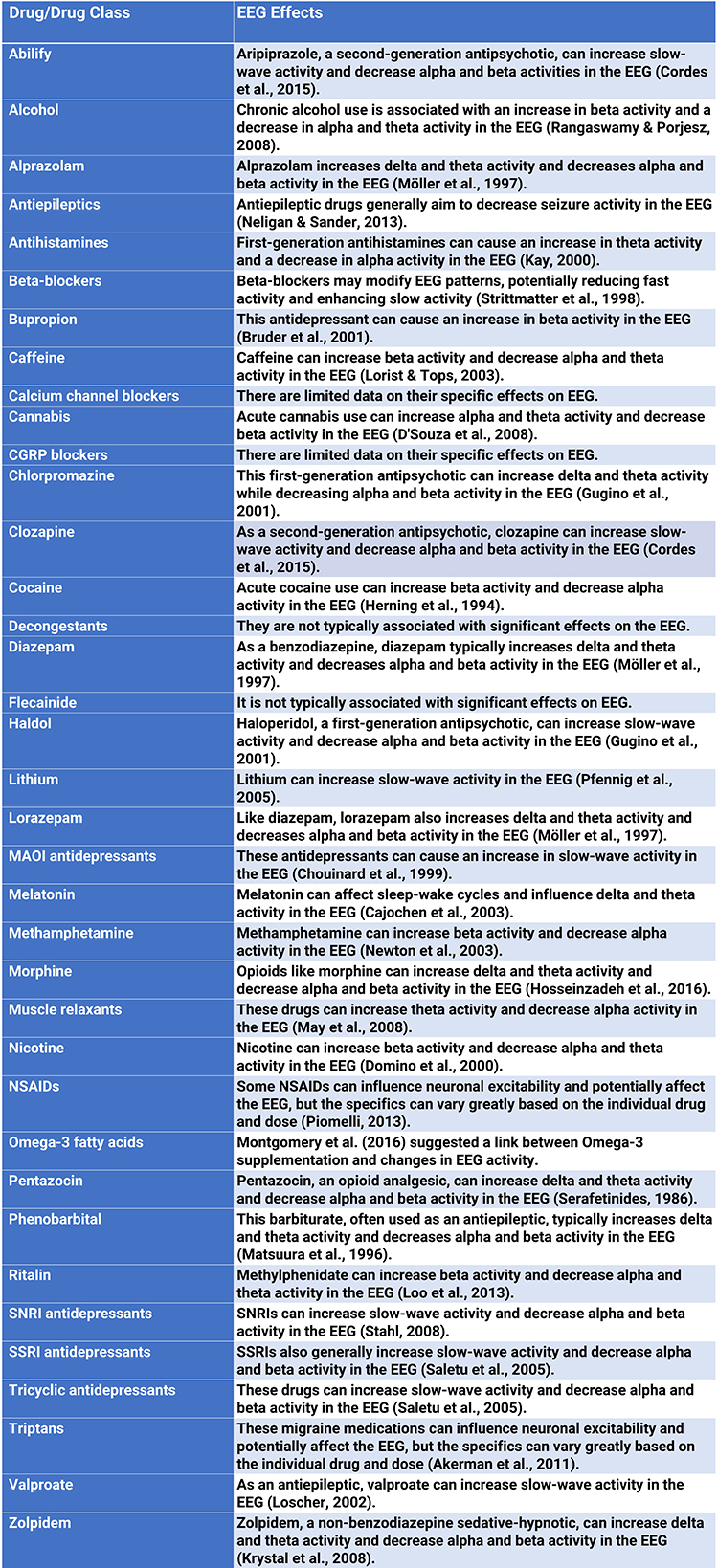
To control drug artifacts, ask clients to list the medications they are currently taking and refrain from ingesting recreational drugs (Fisch, 1999; Thompson & Thompson, 2016).
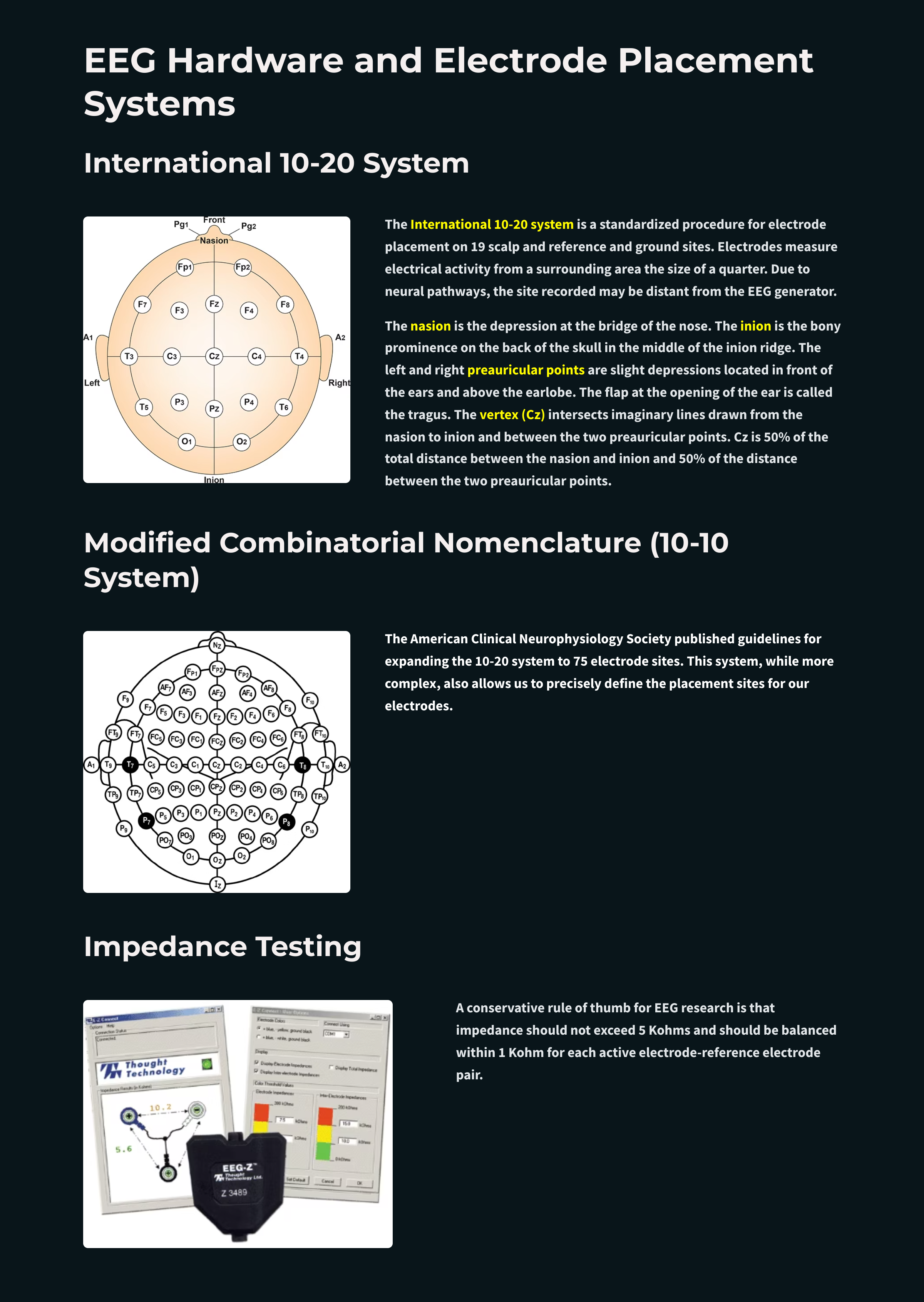
Glossary
50/60 Hz: external artifacts transmitted by nearby electrical sources.
A: the designation for an auricular (ear) site in the International 10-10 and 10-20 systems.
absolute power: the absolute value of power.
active electrode: an electrode placed over a site that is a known EEG generator like Cz.
aliasing: an artifact created during analog-to-digital conversion of a continuous signal by a signal feature near the sampling rate, creating an "alias" of the signal feature as a beat frequency difference with the sampling rate and the signal feature. Aliasing can be caused by a slow sampling rate or a continuous signal with a frequency too close to the sampling rate.
alpha blocking: the replacement of the alpha rhythm by low-amplitude desynchronized beta activity during movement, attention, mental effort like complex problem-solving, and visual processing.
alpha rhythm: 8-13 Hz activity is primarily spread by an intracortical network parallel to the cortical surface. There is only a moderate contribution from neurons in the lateral geniculate nucleus of the thalamus that project to the cortex. Researchers have correlated the alpha rhythm with "relaxed wakefulness."
amplitude: the strength of the EMG signal measured in microvolts or picowatts.
amplitude asymmetry: the difference in signal strength of a frequency band at two EEG sites. For example, the difference in alpha amplitude detected from F3 (left frontal) and F4 (right frontal) sites.
analog filter: analog circuits designed using components like capacitors, resistors, and operational amplifiers designed to remove or enhance signal components.
analog-to-digital (A/D) converter: an electronic device that converts continuous signals to discrete digital values.
autocorrelation: the correlation between a series of values for a single signal.
average reference montage: a combination of derivations that add all remaining 10-20 electrodes in each amplifier's physical or virtual input 2 and compares each active electrode in physical or virtual input 1 against this reference signal. Allows adequate detection of localized EEG activity and electrode artifact but is less appropriate with widely distributed signals.
bandpass filter: a filter that passes frequencies between the set values, the "band" of the filter (e.g., 1-40 Hz).
beat frequency: a false signal produced by the difference between two frequencies, such as seen with binaural beats or in the apparent slow wave in fusiform EEG morphology and aliasing.
beta rhythm: 13-36 Hz rhythm associated with arousal and attention generated by brainstem mesencephalic reticular stimulation that depolarizes neurons in the thalamus and cortex. The beta rhythm can be divided into multiple ranges.
bias potential: a spurious voltage produced by the exchange of metal ions donated by the electrodes and electrolytes in the absence of a biological current.
bipolar recording: a recording method that uses two active electrodes and a common reference.
bipolar montage: a combination of derivations that compares signals from two electrodes often adjacent at 10-20 system coordinates inserted into physical or virtual inputs 1 and 2. Allows good detection of localized EEG activity and electrode artifact but poor detection of widely distributed EEG activity.
bit number: the number of voltage levels that an A/D converter can discern. A resolution of 16 bits means that the converter can discriminate among 65,536 voltage levels.
bridging artifact: a short circuit between adjacent electrodes due to excessive application of electrode paste or a client who is sweating excessively or arrives with a wet scalp.
C: the designation for a central site along the axis between A1 and A2 in the International 10-10 (C5-C6) and 10-20 (C3-C4) systems.
cardiac artifact: contamination of the EEG by the ECG signal.
channel (derivation): an EEG amplifier input from three leads (active, reference, and ground electrodes) placed on the head.
charge (Q): the imbalance between the number of positively and negatively charged particles in a given place or between two locations.
coherence: the correlation between two EEG signals at two recording sites, which is squared to produce values ranging from 0 - 1, to measure the stability of their phase relationship and, therefore, the likelihood of sharing the same generator.
coherence analysis: Porges and Bohrer's procedure to measure the correlation between two EEG signals and compare their arrival times.
coincidence detection: a procedure to control EMG artifact that only records EEG signals (14 Hz) when EMG signals at a predetermined frequency (70 Hz) are absent.
common electrode reference montage: a combination of derivations in which the same ground electrode (distant from the EEG signal source) is inserted into physical or virtual input 2 of each amplifier while a different electrode is placed in physical or virtual input 1 for each derivation. Allows poor detection of localized EEG activity and adequate detection of widely distributed EEG activity.
comodulation: the correlation ranging from 1 to -1 between the amplitudes of specific frequencies recorded at different sites over time and particular conditions (e.g., eyes closed). Comodulation is high when the amplitudes increase and decrease together, suggesting functional coordination between brain sites.
cross-correlation: the correlation between corresponding values of two or more signals at a specific frequency.
DC offset: a voltage that results from combinations of factors including electrode and gel/paste materials, interactions with skin, environment (humidity and temperature), and sweat gland activity due to stress level.
delta rhythm: 0.05-3 Hz oscillations generated by thalamocortical neurons during stage 3 sleep.
derivation: the assignment of two electrodes to an amplifier's inputs 1 and 2.
differential amplifier (balanced amplifier): a device that boosts the difference between two inputs: the active (input 1) and reference (input 2).
digital filter: a device that mathematically removes unwanted or extracts useful aspects of a sampled, discrete-time signal.
drowsiness artifact: stage 1 or stage 2 sleep seen in the drowsy EEG as in adults, 1-Hz (or slower) waveforms. Drowsiness artifact can be detected with the greatest amplitude and reversed polarity at F7 and F8. This artifact may progress to 1-2 Hz slowing of the alpha rhythm.
ECG artifact: noncerebral electrical activity in an EEG recording can be divided into physiological and exogenous artifacts.
EEG topography: a procedure that simultaneously samples multiple EEG, performs Fast Fourier Transformation (FFT) analysis, and maps the cortical surface with color displays of EEG amplitude and frequency.
electrode pop artifact: sudden large deflections in at least one channel when an electrode abruptly detaches from the scalp.
electro-ocular artifact: the contamination of EEG recordings by potentials generated by eye blinks, eye flutter, and eye movements.
electrooculogram (EOG) artifact: the contamination of EEG and EMG recordings by potentials generated by eye blinks, eye flutter, and eye movements. The dipole of the EOG is due to electrical potential differences between the aqueous and vitreous humors of the eye, not as commonly reported due to retinal and corneal electrical charges.
electrostatic artifact: artifactual voltages in EEG and EMG recording that are produced by static electricity.
EMG artifact: interference in EEG recording by volume-conducted signals from skeletal muscles.
epoch: a signal sampling period, for example, a 1-second sample of EEG activity.
epoch number: a location in a session's record. For example, epoch 52 is the 52nd 1-second epoch.
evoked potential artifact (event-related potential artifact): somatosensory, auditory, and visual signal processing-related transients that may contaminate multiple channels of an EEG record.
exogenous artifacts: noncerebral electrical activity generated by movement, 50/60 Hz and field effect, bridging, and electrode (electrode “pop" and impedance) artifacts.
eye flutter artifact: the contamination of EEG recordings by voltages produced by vertical eye movements that can be confused with EEG findings such as frontal intermittent rhythmic delta activity (FIRDA) or frontal midline theta (FMT). Eye flutter is more rapid than eye blinks, with frequencies reported in involuntary eye flutter (nystagmus) up to 20 Hz.
eye movement artifact: deflections in an EEG recording when the dipole of the eye moves toward or away from an electrode in your montage.
eyeblink artifact: the contamination of an EEG recording by high amplitude slow waves produced when the electric dipole of the eye rotates near the adjacent electrodes.
Fast Fourier Transform (FFT) analysis: an algorithm that decomposes a complex waveform into its component frequencies.
field artifacts: external artifacts transmitted by nearby electrical sources.
filter: an electronic circuit that removes or enhances signal components.
finite impulse response (FIR) filter: a digital filtering method.
Fp: the designation for a frontopolar or prefrontal site in the International 10-10 (Fp1, Fpz, and Fp2) and 10-20 (Fp1 and Fp2) systems.
frequency (Hz): the number of complete cycles that an AC signal completes in a second, usually expressed in hertz.
gamma rhythm: EEG activity from 35-45 Hz changes when subjects learn to perceive meaningful patterns, like a Dalmatian concealed by a black and white background.
gold disc electrodes: gold-plated electrodes that produce acceptable electrode noise.
ground electrode: a sensor placed on an earlobe, mastoid bone, or the scalp grounded to the amplifier.
high-frequency filter (HFF): a filter that attenuates frequencies above a cutoff frequency.
high-pass filter: a filter that only passes frequencies higher than a set value (e.g., 1 Hz).
impedance test: the automated or manual measurement of skin-electrode impedance.
infinite impulse response (IIR) filter: a filter with an infinite impulse response and employ feedback as they calculate a moving weighted average of digitally-sampled voltages.
inion: the bony prominence on the back of the skull.
International 10-10 system: the modified combinatorial system for electrode placement that expands the 10-20 system to 75 electrode sites to increase EEG spatial resolution and improve detection of localized evoked potentials.
International 10-20 system: a standardized procedure for placing 21 recording and one ground electrode on adults.
Laplacian montage: a combination of derivations that adds all remaining 10-20 electrodes (weighted by their distance from the single active electrode) in each amplifier's physical or virtual input 2 and compares each electrode in physical or virtual input 1 against this reference signal. Allows good detection of localized EEG activity but poor detection of widely distributed EEG activity.
line current artifact: frequencies at 50/60Hz and their harmonics produced by AC devices can contaminate ECG, EEG, or SEMG recordings. A fluorescent light fixture can create false EEG voltages.
linked-ears reference: two earlobe reference electrodes that are electrically linked or linked in the software.
low frequency filter: an electronic device that attenuates frequencies below a cutoff. For example, a 14-Hz low-frequency filter.
low-pass filter: a filter that only passes frequencies lower than a set value (e.g., 40 Hz).
mastoid bone (or process): the bony prominence behind the ear.
midline (z): the designation for sites along the central axis from nasion to inion in the International 10-10 and 10-20 systems.
monopolar recording: a recording method that uses one active and one reference electrode.
montage: a single channel or a combination of channels (derivations) to detect localized or global EEG activity.
montage reformatting: data analysis where software references an electrode site to other sites or combinations of sites.
movement artifact: voltages caused by client movement or the movement of electrode wires by other individuals.
nasion: the depression at the bridge of the nose.
notch filter: a circuit that suppresses a narrow band of frequencies, such as contamination produced by line current (50/60Hz artifact).
Nyquist-Shannon sampling theorem: the perfect analog signal reconstruction requires sampling at two times its highest frequency. A signal whose highest frequency is 1000 Hz should be sampled 2000 times per second.
O: the designation for an occipital site in the International 10-10 and 10-20 systems.
P: the designation for a parietal site in the International 10-10 and 10-20 systems.
passband: the range of frequencies that is passed through a filter.
peak voltage: 0.5 of the peak-to-peak voltage.
peak-to-peak voltage: the voltage contained between the original AC waveform's positive and negative maximum values.
phase: the degree to which the peaks and valleys of two waveforms coincide.
phase angle: the phase delay measured in degrees between two simultaneously recorded EEG signals from separate scalp locations for each frequency band.
phase distortion: displacement of the EEG waveform in time due to filter processing.
phase-synchronous signals: signals whose peaks and valleys coincide.
physiological artifacts: the noncerebral electrical activity that includes electromyographic, electro-ocular (eye blink and eye movement), cardiac (pulse), sweat (skin impedance), drowsiness, and evoked potential.
picowatt: billionths of a watt.
polarization: a process in which chemical reactions produce separate regions of positive and negative charge where an electrode and electrolyte contact, reducing ion exchange.
posterior dominant rhythm (PDR): the highest-amplitude frequency detected at the posterior scalp when eyes are closed.
power: the measurement of signal strength in picowatts (microvolts2 x 6.65).
power spectral analysis: the measurement of signal amplitude across its frequency range using a Fourier Transform algorithm.
preauricular point: the slight depression located in front of the ear and above the earlobe.
pulse artifacts: noncerebral voltages due to mechanical movement of an electrode with respect to the skin surface due to the pressure wave of each heartbeat.
Quantitative EEG (qEEG): digitized statistical brain mapping using at least a 19-channel montage to measure EEG amplitude within specific frequency bins.
radiofrequency artifact: frequencies from 3 Hz to 300 GHz that contaminate EEG and SEMG recordings. Cell phone transmissions and computer monitors can produce spuriously raise EEG amplitudes.
R-spike: the initial upward deflection in the QRS complex of the ECG.
reference electrode: an electrode placed on the scalp, earlobe, or mastoid.
referential (monopolar) montage: the placement of one active electrode (A) on the scalp and a neutral reference (R) and ground (G) on the ear or mastoid.
relative power: the percentage of absolute power of a frequency with respect to the absolute power of other frequencies measured at a specific electrode.
resolution: the degree of detail in a biofeedback display (0.1 μV) or the number of voltage levels that an A/D converter can discriminate (16 bits or discrimination among 65,536 voltage levels).
sagittal line: in the International 10-10 system, a longitudinal line designated by numerical subscripts.
sequential (bipolar) montage: the placement of active (A) and reference (R) sensors on active scalp sites and the ground (G) to an earlobe or mastoid.
signal strength: the energy contained within the EEG signal quantified by amplitude (μV) or power (picowatts).
silver-silver chloride electrode: an electrode fabricated from a combination of silver and silver-chloride to reduce electrode noise and increase stability in recording very slow EEG frequencies.
slew artifact: the movement of voltages to one side when there are imbalanced impedances between physically-linked ears. Slew artifact is not a problem when the individual ear leads are combined as a "virtual" linked-ears reference in the software.
sweat artifact: changes in the EEG signal when sweat on the skin changes the conductive properties under and near the electrode sites (i.e., bridging artifact).
synchrony: the coordinated firing of pools of neurons due to pacemakers and mutual coordination.
theta rhythm: 4-7 Hz rhythm generated a cholinergic septohippocampal system that receives input from the ascending reticular formation and a noncholinergic system that originates in the entorhinal cortex. w.
time constant: the period during which a biological signal is averaged before it is displayed. For example, a 0.5-second delay between detection and display of EEG.
tongue and swallowing artifact: tongue movement contaminates the delta band, and the entire EEG record detected from frontal or temporal sites may gradually move up or down. This artifact is often a problem with dystonia patients.
tracking test: checking whether the biofeedback display mirrors client behavior. Occipital alpha amplitude should rise when your client closes her eyes and decrease when she focuses on a nearby object.
tragus: the flap at the opening of the ear.
transducer: a device that transforms energy from one form to another. Electrodes convert ionic potentials into electrical potentials.
vertex (Cz): the intersection of imaginary lines drawn from the nasion to inion and between the two preauricular points in the International 10-10 and 10-20 systems.
watt (W): a unit of power used to express signal strength in the qEEG.
Test Yourself
Click on the ClassMarker logo to take 10-question tests over this unit without an exam password.

REVIEW FLASHCARDS ON QUIZLET
Click on the Quizlet logo to review our chapter flashcards.

Visit the BioSource Software Website
BioSource Software offers Human Physiology, which satisfies BCIA's Human Anatomy and Physiology requirement, and Biofeedback100, which provides extensive multiple-choice testing over BCIA's Biofeedback Blueprint.

Essential Skills
1. Explain the EEG and neurofeedback to a client.
2. Explain skin preparation and electrode placement to a client, and obtain permission to monitor her.
3. Identify the major sites of the 10-20 system using a tape measure and marking pencil.
4. Demonstrate skin preparation and electrode placement for scalp and earlobe sites.
5. Explain how to protect the client from infection transmitted by the sensor.
6. Measure electrode impedance for each active-ground electrode pair and ensure that impedance is sufficiently low and balanced.
7. Perform a tracking test for the frequency bands and sites you are monitoring.
8. Identify common artifacts in the raw EEG signal, including 50/60Hz, bridging, drowsiness, ECG, electrode pop, electrostatic, eye blink, eye flutter, eye movements, EMG, EOG, evoked potential, loose electrode, movement, radiofrequency, respiration, sweat, and tongue and swallowing, and explain how to control for them and remove them from the raw data.
9. Demonstrate how to instruct a client to utilize a feedback display.
10. Demonstrate a neurofeedback training session, including record keeping, goal setting, site selection, monitored frequency bands, baseline measurement, display and threshold setting, coaching, and debriefing at the end of the session.
11. Demonstrate how to select and assign a practice assignment based on training session results.
12. Evaluate and summarize client progress during a training session.
Assignment
Now that you have completed this module, identify the recording montages you most often use and summarize their advantages and disadvantages.
References
Andreassi, J. L. (2007). Psychophysiology: Human behavior and physiological response (5th ed.). Lawrence Erlbaum and Associates, Inc.
Cacioppo, J. T., & Tassinary, L. G. (Eds.). (1990). Principles of psychophysiology. Cambridge University Press.
Collura, T. F. (2014). Technical foundations of neurofeedback. Taylor & Francis.
Demos, J. N. (2019). Getting started with neurofeedback (2nd ed.). W. W. Norton & Company.
Evans, J. R., & Abarbanel, A. (1999). Introduction to quantitative EEG and neurofeedback. Academic Press.
Ferree, T. C., Luu, P., Russell, G. S., & Tucker, D. M. (2001). Scalp electrode impedance, infection risk, and EEG data quality. Clinical Neurophysiology, 112, 536-544. https://doi.org/10.1016/s1388-2457(00)00533-2
Fisch, B. J. (1999). Fisch and Spehlmann's EEG primer (3rd ed.). Elsevier.
Floyd, T. L. (1987). Electronics fundamentals: Circuits, devices, and applications. Merrill Publishing Company.
Gratton, G. (1998). Dealing with artifacts: The EOG contamination of the event-related brain potential. Behavior Research Methods, Instruments, & Computers, 1(30), 44-53. https://doi.org/10.3758/BF03209415
Gunkelman, J. (2001). QEEG based neurofeedback protocol design. Presentation at the Marriott Hotel, Woodland Hills, California.
Gunkelman, J. (2008). Personal communication.
Hugdahl, K. (1995). Psychophysiology: The mind-body perspective. Harvard University Press.
Klass, D. W. (2008). The continuing challenge of artifacts in the EEG. EEG artifacts. American Society of Electroneurodiagnostic Technologists, Inc.
Kubala, T. (2009). Electricity 1: Devices, circuits, and materials (9th ed.). Cengage Learning.
La Vaque, T. J. (2003) Neurofeedback, neurotherapy, and quantitative EEG. In D. Moss, A. McGrady, T. Davies, and I. Wickramasekera (Eds.), Handbook of mind-body medicine for primary care. Sage Publications, Inc.
Lau, T. M., Gwin, J. T., & Ferris, D. P. (2012). How many electrodes are really needed for EEG-based mobile brain imaging? Journal of Behavioral and Brain Science, 2(3), 387-393. https://doi.org/10.4236/jbbs.2012.23044
Lebby, P. C. (2013). Brain imaging: A guide for clinicians. Oxford University Press.
Libenson, M. H. (2010). Practical approach to electroencephalography. Saunders Elsevier.
Lin, F., Witzel, T., Hamalainen, M. S., Dale, A. M., Belliveau, J. W., & Stufflebeam, S. M. (2004). Spectral spatiotemporal imaging of cortical oscillations and interactions in the human brain. NeuroImage, 2(3), 582-595. https://dx.doi.org/10.1016%2Fj.neuroimage.2004.04.027
Lubar, J., & Gunkelman, J. (2003). Neurometrics, neurotherapy, and clinical practice. Workshop presented at the 34th annual Association for Applied Psychophysiology and Biofeedback convention, Jacksonville, Florida.
Miller, J. W., Kim, W. S., Homes, M. D., & Vanhatalo, S. (2007). Ictal localization by source analysis of infraslow activity in DC-coupled scalp EEG recordings. NeuroImage, 35(2), 583-597. https://doi.org/10.1016/j.neuroimage.2006.12.018
Nunez, P. L., & Srinivasan, R. (2006). Electric fields of the brain (2nd ed.). Oxford University Press.
Peavey, B. (2003). Effects of drugs on biofeedback. Short course presented at the 34th annual Association for Applied Psychophysiology and Biofeedback convention, Jacksonville, Florida.
Porges, S. W., & Bohrer, R. E. (1990). The analysis of periodic processes in psychophysiological research. In J. T. Cacioppo & L. G. Tassinary (Eds.), Principles of psychophysiology: Physical, social, and inferential elements (pp. 708-753). Cambridge University Press.
Rowan, A. J., & Tolunsky, E. (2003). Primer of EEG with a mini-atlas. Butterworth-Heinemann.
Sterman, M. B., & Kaiser, D. (2001). Comodulation: A new QEEG analysis metric for assessment of structural and functional disorders of the central nervous system. Journal of Neurotherapy, 4(3), 73-83. https://doi.org/10.1300/J184v04n03_05
Stern, R. M., Ray, W. J., & Quigley, K. S. (2001). Psychophysiological recording (2nd ed.). Oxford University Press.
Teplan, M. (2002). Fundamentals of EEG measurement. Measurement Science Review, 2(2), 1-11.
Thomas, C. (2007). What is a montage? EEG instrumentation. American Society of Electroneurodiagnostic Technologists, Inc.
Thompson, M., & Thompson, L. (2015). The biofeedback book: An introduction to basic concepts in applied psychophysiology (2nd ed.). Association for Applied Psychophysiology and Biofeedback.
van Beijsterveldt, C. E. M., Molenaar, P. C. M., de Geus, E. J. C., & Boomsma, D. I. (1998). Genetic and environmental influences on EEG coherence. Behavior Genetics, 28(6), 443-453. https://doi.org/10.1023/a:1021637328512
Wadman, W. J., & Lopes da Silva, F. H. (2011). In D. L. Schomer & F. H. Lopes da Silva (Eds.). Niedermeyer's electroencephalography: Basic principles, clinical applications, and related fields (6th ed.). Lippincott Williams & Wilkins.